> ARI : News on the Net : news on world archaeology (Audio, Blogs, Text, Video).
> Daily archaeology news from the Internet (on www.archaeologica.org).
> Latest publications : North Africa, Sahara, West Africa - in french
> Latest publications : Central Africa - in french
> African-archaeology.net news archives : 2012 - 2011 - 2010 - 2008 - 2007 - 2006 -
2012 NEWS CONTENTS:
=> Early Human Ancestors May Have Walked AND Climbed for a Living (Africa) 31 December 2012
=> Scientists Research First Stone Tool Industries in Olduvai Gorge (Tanzania) 22 December 2012
=> Scientists 'Surprised' to Discover Very Early Ancestors Survived On Tropical Plants,
New Study Suggests (Africa) 14 December 2012
=> Tracing humanity's African ancestry may mean rewriting 'out of Africa' dates (Africa)
13 December 2012
=> The First Modern Humans Arose in South Africa, Say Researchers (South Africa) 5 December 2012
=> Sorry, vegans: Eating meat and cooking food made us human (Africa) 19 November 2012
=> Anthropologist finds large differences in gait of early human ancestors (Africa) 12 November 2012
=> Small lethal tools have big implications for early modern human complexity (South Africa)
7 November 2012
=> Human expansion from Africa comes into focus (Africa) 1 November 2012
=> New Stanford analysis provides fuller picture of human expansion from Africa (Africa) 22 October 2012
=> Study Suggests Early Humans Ate Meat 1.5 Million Years Ago (Tanzania, East Africa) 3 October 2012
=> Humans hunted for meat 2 million years ago (Tanzania, East Africa) 23 September 2012
=> Extensive DNA Study Sheds Light on Modern Human Origins (Africa) 20 September 2012
=> Studies slow the human DNA clock (Africa) 18 September 2012
=> DNA hints at African cousin to humans (Africa) 8 September 2012
=> Stone-Tipped Spears Used Much Earlier Than Thought, Say Researchers (South Africa)
8 September 2012
=> Malian treasures trapped in a culture war (Mali, West Africa) 25 August 2012
=> New Life for Nubian Bones (Egypt, North Africa) 20 August 2012
=> Climate and Drought Lessons from Ancient Egypt (Egypt, North Africa) 16 August 2012
=> Fossils point to a big family for human ancestors (Africa) 8 August 2012
=> Multiple Species of Early Homo Lived in Africa (Africa) 8 August 2012
=> Malindi archaeologists make new discoveries (Kenya, East Africa) 4 August 2012
=> A Modern Culture Emerged 44,000 Years Ago (South Africa) 30 July 2012
=> Modern culture emerged in Africa 20,000 years earlier than thought (South Africa) 30 July 2012
=> Sudan's Archaeological Sites Threatened by Proposed Dams (Sudan, East Africa) 22 July 2012
=> S.African scientists find most complete pre-human skeleton (South Africa) 12 July 2012
=> Timbuktu Arabs set up armed watch at ancient tombs (Mali, West Africa) 11 July 2012
=> Sudan relics at risk from dam floods. Appeal to archaeological community as proposals leave
three- to six-year window (Sudan, East Africa) 10 July 2012
=> DNA clues to Queen of Sheba tale (Ethiopia, East Africa) 21 June 2012
=> Ancient North Africans got milk. Herders began dairying around 7,000 years ago (Lybia, North Africa)
20 June 2012
=> Archaeological Site in Kenya Opening Window on Early Human Tool-Making (Kenya, East Africa)
13 June 2012
=> Thieves go on a treasure hunt in Egypt, taking advantage of country's turmoil (Egypt, North Africa)
13 May 2012
=> Ancient walking gets weirder: Fossils from two human ancestors suggest diversity in gait, stance
(Kenya, East Africa) 19 April 2012
=> Wadi Abu Subeira, Egypt: Palaeolithic rock art on the verge of destruction (Egypt, North Africa)
6 April 2012
=> Cutting through ancient evidence of human tool use (East Africa) 6 April 2012
=> Analytical standards needed for 'reading' Pliocene bones (East Africa) 5 April 2012
=> Scientists find evidence that human ancestors used fire one million years ago,
300,000 years earlier than believed (South Africa) 2 April 2012
=> First of Our Kind: Could Australopithecus sediba Be Our Long Lost Ancestor? (Africa, Southern Africa)
April 2012
=> 'Lucy' Lived Among Close Cousins: Discovery of Foot Fossil Confirms Two Human Ancestor Species
Co-Existed (Ethiopia, East Africa) 28 March 2012
=> Massive looting at El Hibeh, Egypt (Egypt, North Africa) 13 March 2012
=> Stone Age Pebble Holds Mysterious Meaning (South Africa) 23 February 2012
=> Making the bones speak (Sudan, East Africa) 22 February 2012
=> Out of Africa? Data fail to support language origin in Africa (Africa) 15 February 2012
=> Human evolution: Cultural roots (South Africa) 15 February 2012
=> Tunisia: Discovery of a Roman Cemetery in Djerba (North Africa, Tunisia) 14 February 2012
=> Ancient Farmers had Impact on Disappearance of African Rainforests (Central Africa) 9 February 2012
=> Czech archaeologists discover long-lost temple in Sudan (Sudan, East Africa) 27 January 2012
=> Arabia the First Stop for Modern Humans Out of Africa, Suggests New Study (Africa) 26 January 2012
=> Facebook in our Genes? (Southern Africa) 25 January 2012
=> Anthropology researcher searches for slave-era shipwreck (South Africa) 19 January 2012
=> River bank life of Early Humans (Ethiopia, East Africa) 15 January 2012
=> New Early Warning System Spotlights Endangered Archaeological and Cultural Heritage Sites
(Africa) 8 January 2012
=> Spreading a message of hope for Libyan archaeology (Lybia, North Africa) 7 January 2012
=> Look into the eyes of a rare ancient African sculpture (Nigeria, West Africa) 6 January 2012
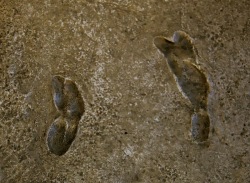 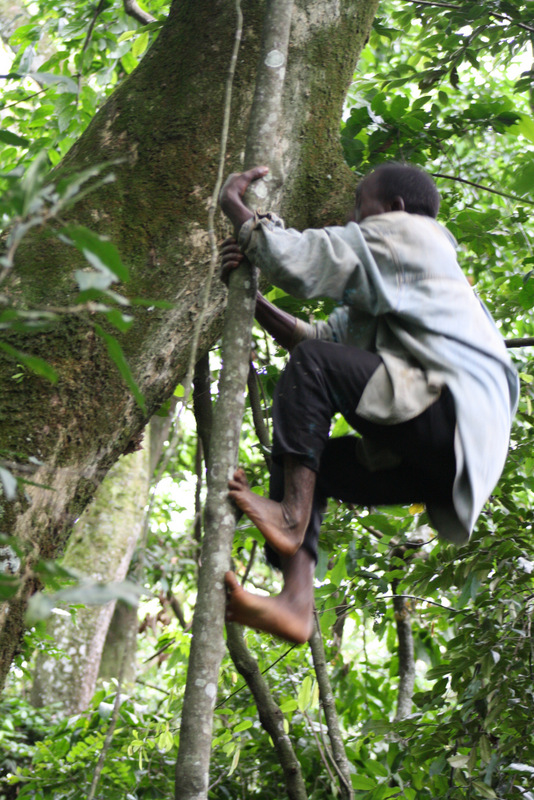 A Twa hunter-gatherer in Uganda climbing a tree to gather honey. Credit: Nathaniel Dominy |
Early Human Ancestors May Have Walked AND Climbed for a Living (Africa) 31 December 2012 The results of recently conducted field studies on modern human groups in the Philippines and Africa are suggesting that humans, among the primates, are not so unique to walking upright as previously thought. The findings have implications for some of our earliest possible ancestors, including the 3.5+ million-year-old species Australopithecus afarensis, thought by many scientists to be the first known possible human predecessor to have forsaken arboreal life in the trees and live a life walking upright (bipedalism) on the ground. Associate professor of anthropology Nathaniel Dominy of Dartmouth College, along with colleagues Vivek Venkataraman and Thomas Kraft, compared African Twa hunter-gatherers to agriculturalists living nearby, the Bakiga, in Uganda. In the Philippines, they compared the Agta hunter-gatherers to the Manobo agriculturalists. They found that the Twa and the Agta hunter-gatherers regularly climbed trees to gather honey, an important element in their diets. More specifically, they observed that the climbers "walked" up small trees by applying the soles of their feet directly to the trunk and progressing upward, with arms and legs advancing alternately. To do this successfully, they said, required extreme dorsiflexion, or bending the foot upward toward the shin to a degree not normally possible among most modern humans. "We hypothesized that a soft-tissue mechanism might enable such extreme dorsiflexion," wrote the authors in their study report. They tested their hypothesis by conducting ultrasound imaging of the fibers of the large calf muscles of individuals in all four groups. The results showed that the Agta and Twa tree-climbers had significantly longer muscle fibers than those of their agricultural counterparts and other "industrialized" modern humans. "These results suggest that habitual climbing by Twa and Agta men changes the muscle architecture associated with ankle dorsiflexion," wrote the authors of the study. It demonstrated that a foot and ankle bone structure adapted primarily for walking upright on land does not necessarily exclude climbing as a behaviorally habitual means of mobility for survival. The implications for our possible early human ancestors, such as the species Australopithecus afarensis, are significant. "Australopithecus afarensis possessed a rigid ankle and an arched, nongrasping foot," wrote Dominy and his co-authors in the report published in the Proceedings of the National Academy of Sciences (PNAS). "These traits are widely interpreted as being functionally incompatible with climbing and thus definitive markers of terrestriality." But now, the research shows that bone structure alone is not an indisputable indicator that an ancient hominid was exclusively terrestrial. Australopithecus afarensis is an extinct hominid that lived between 3.9 and 2.9 million years ago. It was first discovered by Donald Johanson and colleagues in the Afar region of Ethiopia with the recovery of the partial skeleton of a 3.2 million-year-old specimen they named "Lucy". The find has represented a possible benchmark in human evolution for decades. Along with being among the earliest possible bipedal primates, it has also been thought to be closely related to the genus Homo (which includes the modern human species Homo sapiens), either as a direct ancestor or indirectly through an unknown earlier ancestor. Source : http://popular-archaeology.com/issue/december-2012/article/scientists-research-first-stone-tool-industries-in-olduvai-gorge
|
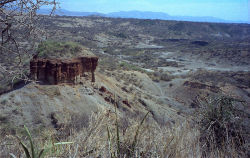  A chopping tool from Olduvai Gorge, 1 - 2 million years old. GFDL CC-BY-SA, Wikimedia Commons 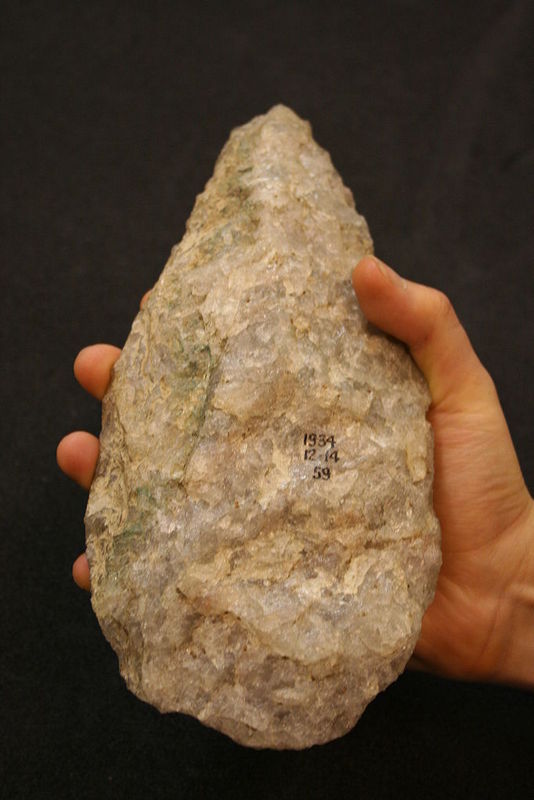 A handaxe from Olduvai Gorge, over 1 million years old. This stone tool is most often associated with Homo erectus, a hominin considered by many scientists to be a possible human (Homo) ancestor. Homo erectus is widely thought to be the first species to venture out of Africa to populate the Middle East/Eurasia. British Museum, Discott, Wikimedia Commons |
Scientists Research First Stone Tool Industries in Olduvai Gorge (Tanzania) 22 December 2012 An international team of researchers have returned to Olduvai Gorge in Tanzania to unravel the mystery of how humans transitioned from the first stone tool technology to a more sophisticated industry. Olduvai Gorge, perhaps the most famous site for evidence of early humans, is again the subject of intense research on a decades-old question bearing on human origins: How, when and where did early humans evolve from using the first and simplest stone tool industry, that of Oldowan, to the second-oldest, and more sophisticated, stone tool technology known as the Acheulean? While Olduvai has been picked over before, most notably by the pioneering scientists L.S.B. and Mary Leakey, advances in archaeological investigative methods and the application of multidisciplinary approaches have made it possible to take another, more detailed and comprehensive look at both the old and the new among the world-famous exposed beds, the geological earthen layers or deposits that have historically produced some of the great ground-breaking discoveries related to early human evolution. Now, under the organizational umbrella of the Olduvai Geochronology Archaeology Project, an international team of scientists composed of a consortium of researchers and institutions is focusing on reconstructing the picture of the early human transition from the simple "chopper" stone tool technology of the Oldowan industry (see image below), the world's first technology discovered at Olduvai, to the Acheulean, the more sophisticated technology represented most by the well-known bifacial "handaxe" (see image below), some of the first examples of which were found at Saint- Acheul in France, and later at Olduvai. The Oldowan is considered to have been made and used during the Lower Paleolithic, from 2.6 to 1.7 million years ago, whereas the Acheulean emerged about 1.76 million years ago and was used by early humans up to about 300,000 years ago or later. To find answers, the team will be reappraising the chronological stratigraphy of Bed II, known to have yielded previous significant finds, and will be re-excavating some of the later beds of the best known fossil and stone tool sites. These beds reveal a record of a very important time period (1.79 - 1.15 million years ago), a record that contains evidence of critical changes in the area's fauna, stone tools and climate, such as the disappearance of Homo habilis, a very early hominin and possible human ancestor, and the emergence of Homo erectus, a later hominin considered to be the earliest human ancestor to exit Africa and spread across Eurasia. Scientists suggest that these same beds may include evidence of the long-sought transition from the more primitive Oldowan stone tools to the appearance of the more advanced Acheulean tools. Recent research at Olduvai has focused primarily on earlier beds, so research on these later beds will likely present new data to consider. Four key previously excavated sites will be investigated through full-scale excavation. More specifically, the team's objectives are including the following activities: - Conducting test pits (very limited, targeted excavations) at selective Bed II sites that have been determined to contain possible evidence related to the emergence of Acheulean tools at Olduvai; - Applying the new landscape sampling approach across Middle and Upper Bed II deposits and conducting random test pits in the various paleo-ecological settings; - Applying advanced dating methodologies to Bed II volcanic ashes to produce higher-resolution, more accurate dates for Bed II locations; - Measuring stratigraphic sections at and between key archaeological sites to determine their relative order and paleoecological contexts; - Determining the correlation of volcanic ash layers between sites to test previous proposed correlations and then establishing the basin-wide stratigraphic framework for Bed II; and finally, - Reconstructing the paleo-environments at Olduvai during the 1.7-1.3 Ma time period. Source : http://popular-archaeology.com/issue/december-2012/article/scientists-research-first-stone-tool-industries-in-olduvai-gorge
|
 New research suggests that between three million and 3.5 million years ago, the diet of our very early ancestors in central Africa is likely to have consisted mainly of tropical grasses and sedges. (Credit: © timur1970 / Fotolia) |
Scientists 'Surprised' to Discover Very Early Ancestors Survived On Tropical Plants, New Study Suggests (Africa) 14 December 2012 New research by a University of Alberta archeologist may lead to a rethinking of how, when and from where our ancestors left Africa. Researchers involved in a new study led by Oxford University have found that between three million and 3.5 million years ago, the diet of our very early ancestors in central Africa is likely to have consisted mainly of tropical grasses and sedges. The findings are published in the early online edition of Proceedings of the National Academy of Sciences. An international research team extracted information from the fossilised teeth of three Australopithecus bahrelghazali individuals -- the first early hominins excavated at two sites in Chad. Professor Julia Lee-Thorp from Oxford University with researchers from Chad, France and the US analysed the carbon isotope ratios in the teeth and found the signature of a diet rich in foods derived from C4 plants. Professor Lee-Thorp, a specialist in isotopic analyses of fossil tooth enamel, from the Research Laboratory for Archaeology and the History of Art, said: "We found evidence suggesting that early hominins, in central Africa at least, ate a diet mainly composed of tropical grasses and sedges. No African great apes, including chimpanzees, eat this type of food despite the fact it grows in abundance in tropical and subtropical regions. The only notable exception is the savannah baboon which still forages for these types of plants today. We were surprised to discover that early hominins appear to have consumed more than even the baboons." The research paper suggests this discovery demonstrates how early hominins experienced a shift in their diet relatively early, at least in Central Africa. The finding is significant in signalling how early humans were able to survive in open landscapes with few trees, rather than sticking only to types of terrain containing many trees. This allowed them to move out of the earliest ancestral forests or denser woodlands, and occupy and exploit new environments much farther afield, says the study. The fossils of the three individuals, ranging between three million and 3.5 million years old, originate from two sites in the Djurab desert. Today this is a dry, hyper-arid environment near the ancient Bahr el Ghazal channel which links the southern and northern Lake Chad sub-basins. However, in their paper the authors observe that at the time when Australopithecus bahrelghazali roamed, the area would have had reeds and sedges growing around a network of shallow lakes, with floodplains and wooded grasslands beyond. Previously, it was widely believed that early human ancestors acquired tougher tooth enamel, large grinding teeth and powerful muscles so they could eat foods like hard nuts and seeds. This research finding suggests that the diet of early hominins diverged from that of the standard great ape at a much earlier stage. The authors argue that it is unlikely that the hominins would have eaten the leaves of the tropical grasses as they would have been too abrasive and tough to break down and digest. Instead, they suggest that these early hominins may have relied on the roots, corms and bulbs at the base of the plant. Professor Lee-Thorp said: "Based on our carbon isotope data we can't exclude the possibility that the hominins' diets may have included animals that in turn ate the tropical grasses. But as neither humans nor other primates have diets rich in animal food, and of course the hominins are not equipped as carnivores are with sharp teeth, we can assume that they ate the tropical grasses and the sedges directly." Source : http://www.sciencedaily.com/releases/2012/12/121214200916.htm
|
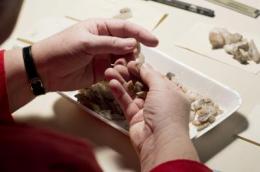 U of A anthropologist Willoughby believes that the items found prove continuous occupation of the areas over the last 200,000 years, through what is known as the "genetic bottleneck" period of the last ice age. Credit: John Ulan/ University of Alberta |
Tracing humanity's African ancestry may mean rewriting 'out of Africa' dates (Africa) 13 December 2012 New research by a University of Alberta archeologist may lead to a rethinking of how, when and from where our ancestors left Africa. U of A researcher and anthropology chair Pamela Willoughby's explorations in the Iringa region of southern Tanzania yielded fossils and other evidence that records the beginnings of our own species, Homo sapiens. Her research, recently published in the journal Quaternary International, may be key to answering questions about early human occupation and the migration out of Africa about 60,000 to 50,000 years ago, which led to modern humans colonizing the globe. From two sites, Mlambalasi and nearby Magubike, she and members of her team, the Iringa Region Archaeological Project, uncovered artifacts that outline continuous human occupation between modern times and at least 200,000 years ago, including during a late Ice Age period when a near extinction-level event, or "genetic bottleneck," likely occurred. Now, Willoughby and her team are working with people in the region to develop this area for ecotourism, to assist the region economically and create incentives to protect its archeological history. "Some of these sites have signs that people were using them starting around 300,000 years ago. In fact, they're still being used today," she said. "But the idea that you have such ancient human occupation preserved in some of these places is pretty remarkable." Magubike: Home to a modern Stone Age family? Willoughby says one of the fascinating things about Magubike is the presence of a large rock shelter with an intact overhanging roof. The excavations yielded unprecedented ancient artifacts and fossils from under this roof. Samples from the site date from the earliest stages of the middle Stone Age to the Iron Age. The earlier deposits include human teeth and artifacts such as animal bones, shells and thousands of flaked stone tools. The Iron Age finds can be dated using radiocarbon, but the older deposits must go through more specialized processes, such as electron spin resonance, to determine their age. Other parts of the Magubike rock shelter, excavated in 2006 and 2008, include occupations from after the middle Stone Age. Taken together, this information could be crucial to tracking the evolutionary development of the inhabitants. "What's important about the whole sequence is that we may have a continuous record of human occupation," said Willoughby. "If we do—and we can prove it through these special dating techniques—then we have a place people lived in over the bottleneck." Rugged, hilly terrain may have been key to survival The team made similar findings at Mlambalasi, about 20 kilometres from Magubike. Among the findings at this site was a fragmentary human skeleton that probably dates to the late Pleistocene Ice Age—after the out-of-Africa expansion but at the end of the bottleneck period. The bottleneck theory explains what geneticists have found by studying the mitochondrial DNA of living people—that all non-Africans are descended from one lineage of people who left Africa about 50,000 years ago. Reconstructions of past environments through pollen and other archeological records in Iringa suggest that people abandoned the lowland, tropical and coastal areas during that period but remained in the highlands, where vegetation has remained mostly unchanged over the last 50,000 years. Those who moved to higher ground may have found what is likely one of the few places that facilitated their survival and forced their adaptation. Further testing will determine whether these findings point to a clearer link to our African ancestors—a find Willoughby says could put that region of Tanzania on many archeologists' radar. "It was only about 20 years ago that people recognized that modern Homo sapiens actually had an African ancestry, and everyone was focused on looking at early Homo sapiens in Europe who appeared around 40,000 years ago," she said. "But we now know that as far as back as around 200,000 years ago, Africa was inhabited by people who were already physically exactly like us today or really close to being the same as us. All of a sudden, it's not Europe in this time period that's really important, it's Africa." Engaging community yields co-operation, opportunity Along with its scientific significance, Willoughby's work may be a linchpin to potential economic growth for the region. Since 2005, when a local cultural officer showed her the sites, she has been sharing information about her research with local citizens, schools and government—opening up opportunities for more research and co-operation. She keeps the region informed of the team's findings through posters distributed around Iringa, and has asked for and accepted assistance from local scholars. Now the community is also looking for her help in establishing the historic sites as a tourist attraction that will benefit the region. Willoughby says she feels fortunate to have the support of the Tanzanian people. She tells people it is a shared history she is uncovering, something she is honoured to be able to do. "They're telling me, 'You're putting Iringa on the map,'" she said. "As long as they keep letting me work there, and keep letting the people working with me work there, we'll be happy." Source : http://phys.org/news/2012-12-humanity-african-ancestry-rewriting-africa.html
|
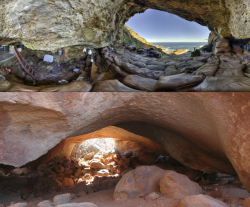 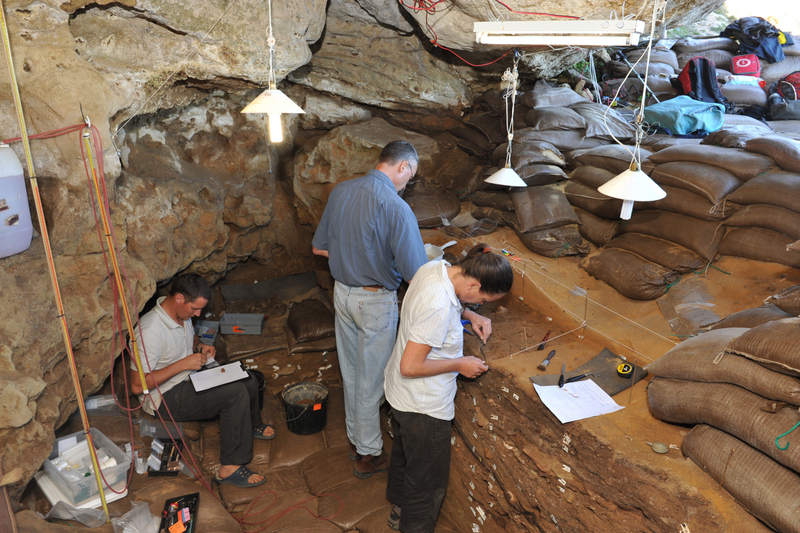 Excavations in progress within the Still Bay levels at Blombos Cave, southern Cape, South Africa. Courtesy Christopher Henshilwood and the University of the Withwatersrand |
The First Modern Humans Arose in South Africa, Say Researchers (South Africa) 5 December 2012 The synthesis of years of research at prehistoric sites in southern Africa, as represented by research recently published in the Journal of World Prehistory, has led a number of scientists to suggest that South Africa was the primary center for the early development of modern human behavior. This would mean cognitive behavior as manifested in technology much like the material culture of modern hunter-gatherer groups throughout the world today. The new research paper by renowned Wits University archaeologist, Prof. Christopher Henshilwood, is the first detailed summary of Middle Stone Age (280,000 - 50,000 years ago) technologies and cultural remains discovered at a number of sites in southern Africa, artifacts that fall within two established overall "techno-tradition" periods: Still Bay (dated to c. 75,000 – 70,000 years ago) and Howiesons Poort (c. 65,000 – 60,000 years ago). Henshilwood maintains that these periods were significant markers in the development of Homo sapiens behavior in southern Africa. They featured a number of innovations including, for example, the first abstract art (engraved ochre* and engraved ostrich eggshell); the first jewellery (shell beads); the first bone tools; the earliest use of the pressure flaking technique, used in combination with heating to make stone spear points; and the first probable use of stone tipped arrows launched by bow. (See examples pictured below). “All of these innovations, plus many others we are just discovering, clearly show that Homo sapiens in southern Africa at that time were cognitively modern and behaving in many ways like ourselves. It is a good reason to be proud of our earliest, common ancestors who lived and evolved in South Africa and who later spread out into the rest of the world after about 60,000 years,” says Henshilwood. The research also addresses some of the nagging questions about what drove our ancestors to develop these innovative technologies. According to Henshilwood, answers to these questions are, in part, found in demography and climate change, particularly changing sea levels, which have been generally found to be major drivers of innovation and variability in material culture. Henshilwood and his colleagues' extensive research in African archaeology has challenged the previous prevailing model of the emergence of behaviorally modern humans, which has suggested that modern human behavior originated in Europe after about 40,000 years ago. Now, there is increasing evidence for an African origin for behavioral and technological modernity more than 70,000 years ago, and that the earliest origin of all Homo sapiens may lie in Africa and more particulalry southern Africa. Henshilwood writes: “In just the past decade our knowledge of Homo sapiens behaviour in the Middle Stone Age, and in particular of the Still Bay and Howiesons Poort, has expanded considerably. With the benefit of hindsight we may ironically conclude that the origins of ‘Neanthropic Man’, the epitome of behavioural modernity in Europe, lay after all in Africa.” Source : http://popular-archaeology.com/issue/december-2012/article/the-first-modern-humans-arose-in-south-africa-say-researchers
|
 A feast fit for ... our prehuman ancestors? While vegetarian, vegan and raw diets can be healthy today - likely far healthier than the typical American diet, to continue to call these diets "natural" for humans, in terms of evolution, is a bit of a stretch. |
Sorry, vegans: Eating meat and cooking food made us human (Africa) 19 November 2012 High caloric intake enabled brains of our prehuman ancestors to grow dramatically Vegetarian, vegan and raw diets can be healthy — likely far healthier than the typical American diet. But to continue to call these diets "natural" for humans, in terms of evolution, is a bit of a stretch, according to two recent, independent studies. Eating meat and cooking food made us human, the studies suggest, enabling the brains of our prehuman ancestors to grow dramatically over a period of a few million years. Although this isn't the first such assertion from archaeologists and evolutionary biologists, the new studies demonstrate, respectively, that it would have been biologically implausible for humans to evolve such a large brain on a raw, vegan diet and that meat-eating was a crucial element of human evolution at least 1 million years before the dawn of humankind. Shhh, don't tell the gorillas At the core of this research is the understanding that the modern human brain consumes 20 percent of the body's energy at rest, twice that of other primates. Meat and cooked foods were needed to provide the necessary calorie boost to feed a growing brain. [ 10 Things You Didn't Know About the Human Brain ] One study, published last month in the journal Proceedings of the National Academy of Sciences, examined the brain sizes of several primates. For the most part, larger bodies have larger brains across species. Yet humans have exceptionally large, neuron-rich brains for our body size, while gorillas — three times more massive than humans — have smaller brains and three times fewer neurons. Why? The answer, it seems, is the gorillas' raw, vegan diet (devoid of animal protein), which requires hours upon hours of eating only plants to provide enough calories to support their mass. Researchers from Brazil, led by Suzana Herculano-Houzel, a neuroscientist at the Federal University of Rio de Janeiro in Brazil, calculated that adding neurons to the primate brain comes at a fixed cost of approximately six calories per billion neurons. For gorillas to evolve a humanlike brain, they would need an additional 733 calories a day, which would require another two hours of feeding, the authors wrote. A gorilla already spends as much as 80 percent of the tropic's 12 hours of daylight eating. Similarly, early humans eating only raw vegetation would have needed to munch for more than nine hours a day to consume enough calories, the researchers calculated. Thus, a raw, vegan diet would have been unlikely given the danger and other difficulties of gathering so much food. Cooking makes more foods edible year-round and releases more nutrients and calories from both vegetables and meat, Herculano-Houzel said. "The bottom line is, it is certainly possible to survive on an exclusively raw diet in our modern day, but it was most likely impossible to survive on an exclusively raw diet when our species appeared," Herculano-Houzel told LiveScience. The study puts an upper limit on how big a brain is able to grow while on a premodern raw, vegan diet. But the researchers could not determine when daily cooking began. Was it about 250,000 years ago, when humans were nearly fully evolved with big brains, which is supported by archaeological findings; or was it about 800,000 years ago, when prehumans began their most dramatic brain-growth spurt, an era for which there is little archaeological evidence of controlled fires for cooking? Meet the meat-eater If cooking wasn't routine in the years before the dawn of modern humans, eating meat certainly was. The second study, published in October the journal PLoS ONE, examined the remains of a prehuman toddler who died from malnutrition about 1.5 million years ago. Shards of a skull found in modern-day Tanzania reveal that the child had porotic hyperostosis, a type of spongy bone growth associated with low levels of dietary iron and vitamins B9 and B12, the result of diet lacking animal products in a species that requires them. [ 10 Mysteries of the First Humans ] The child was around the weaning age. So, either the child's mother's breast milk lacked key nutrients, or the child himself did not consume enough nutrients directly from meat or eggs. Either way, the finding implies that meat must have been an integral, and not sporadic, element of the prehuman diet more than 1 million years ago, said the study's lead author, Manuel Domínguez-Rodrigo, an archaeologist at Complutense University in Madrid. This supports the theory that meat fueled human brain evolution because meat — from arachnids to zebras — was plentiful on the African savanna, where humans evolved, and is the best package of calories, proteins, fats and vitamin B12 needed for brain growth and maintenance. "Carnivore animals, whether terrestrial or aquatic, are bigger brained than herbivores," Domínguez-Rodrigo told LiveScience. And he added that "there is no [traditional] society that live as vegans," essentially because it wouldn't be possible to get vitamin B12, which is only available in animal products. Vegetables still healthy Both sets of researchers said their conclusion — that cooked food and meat were necessary for human brain development — is not a statement of how the human diet must have been, but rather how it likely was in order to make humans "human." With supermarkets and refrigeration, humans today can and increasingly do eat a vegetarian or vegan diet year-round. And given the amount of heart-stopping saturated fats in factory-produced animal products, a plant-based diet can be healthier. Yet both "extreme sides" of the meat argument — the unapologetic meat eater and the raw vegan — should remember that few so-called natural foods today were around as little as a few hundred years ago, from the modern invention called corn-fed beef to genetically altered strains of Queen Anne's lace called the carrot. From health to the environment, there are many reasons to go vegetarian, go vegan and even go raw, but evolution isn't one of them. Source : http://www.nbcnews.com/id/49888012/ns/technology_and_science-science/#.UXLIeMq5oe9
|
 A sculptor's rendering of the hominid Australopithecus afarensis is displayed as part of an exhibition that includes the 3.2 million year old fossilized remains of "Lucy", the most complete example of the species, at the Houston Museum of Natural Science, 28 August 2007 in Houston, Texas. |
Anthropologist finds large differences in gait of early human ancestors (Africa) 12 November 2012 Patricia Ann Kramer, professor of anthropology at the University of Washington, has found that the walking gait between two of our early ancestors was likely so different that it's doubtful they would have done so together, despite being two members of the same species living during roughly the same time period. In her paper published in the American Journal of Physical Anthropology, Kramer outlines how she compared the natural walking speeds of modern humans to those of two members of the Australopithecus afarensis species and found that such large differences existed between two members of our early ancestors that walking together would have been troublesome. In her study, Kramer compared the bones of Lucy, the famous skeletal remains found in Ethiopia, with those of Kadanuumuu (Big Man in Afar) another member of the A. afarensis species unearthed in 2010, though clearly much larger. Because of their difference in height – Lucy would have been about 3.5 feet tall, Big Man approximately 5 – Kramer wondered if they would have been able to walk around together. To find out, she enlisted the aid of 36 children and 16 adults who all agreed to have their leg bones measured and then to be tested walking on a treadmill. Scientists know that people have a natural walking gait that is also the optimal speed for conserving energy. For long legged people, a faster gait is optimal, whereas for those with shorter legs, slower is better. In the case of Lucy and Big Man, the difference in the length of leg bones would have been equivalent to the difference in leg bone length between modern children and adults. She used the data from her volunteers' efforts to create a mathematical formula that allowed her to estimate the natural gait of Lucy and Big Man and found them to be 3.4 feet per second, versus 4.4 feet per second. Such a difference would have meant Lucy would have had to walk a lot faster than normal to keep up with Big Man, or Big Man would have had to walk a lot slower for the two of them to walk around together; an idea that seems counterintuitive because it would mean one or the other would have had to walk at a pace that consumed more energy. Kramer notes that her study includes just two specimens of A. afarensis which are of the opposite gender, and who would have lived some distance from one another. Thus, she suggests it's possible that regional differences were at play, or that males of the time were simply much larger than females, which likely would have meant they spent most of their time apart, similar to modern chimpanzees. Abstract: The estimated lower limb length (0.761–0.793 m) of the partial skeleton of Australopithecus afarensis from Woranso-Mille (KSD-VP-1/1) is outside the previously known range for Australopithecus and within the range of modern humans. The lower limb length of KSD-VP-1/1 is particularly intriguing when juxtaposed against the lower limb length estimate of the other partial skeleton of A. afarensis, AL 288-1 (0.525 m). A sample of 36 children (age, >7 years, trochanteric height = 0.56–0.765 m) and 16 adults (trochanteric height = 0.77–1.00 m) walked at their self-selected slow, preferred, and fast walking velocities, while their oxygen consumption was monitored. Lower limb length and velocity were correlated with slow (P < 0.001, r2 = 0.44), preferred (P < 0.001, r2 = 0.55), and fast (P < 0.001, r2 = 0.69) walking velocity. The relationship between optimal velocity and lower limb length was also determined and lower limb length explained 47% of the variability in optimal velocity. The velocity profile for KSD-VP-1/1 (slow = 0.73–0.75 m/s, preferred = 1.08–1.11 m/s, and fast = 1.48–1.54 m/s) is 36–44% higher than that of AL 288-1 (slow = 0.53 m/s, preferred = 0.78 m/s, and fast = 1.07 m/s). The optimal velocity for AL 288-1 is 1.04 m/s, whereas that for KSD-VP-1/1 is 1.29–1.33 m/s. This degree of lower limb length dimorphism suggests that members of a group would have had to compromise their preferences to walk together or to split into subgroups to walk at their optimal velocity. Source : http://phys.org/news/2012-11-anthropologist-large-differences-gait-early.html
|
 Pinnacle Point, South Africa, with Cave Opening 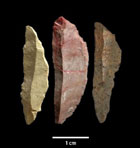 Microlith Blades  Inside Pinnacle Point Cave |
Small lethal tools have big implications for early modern human complexity (South Africa) 7 November 2012 On the south coast of South Africa, scientists have found evidence for an advanced stone age technology dated to 71,000 years ago at Pinnacle Point near Mossel Bay. This technology, allowing projectiles to be thrown at greater distance and killing power, takes hold in other regions of Africa and Eurasia about 20,000 years ago. When combined with other findings of advanced technologies and evidence for early symbolic behavior from this region, the research documents a persistent pattern of behavioral complexity that might signal modern humans evolved in this coastal location. These findings were reported in the article "An Early and Enduring Advanced Technology Originating 71,000 Years Ago in South Africa" in the November 7 issue of the journal Nature. "Every time we excavate a new site in coastal South Africa with advanced field techniques, we discover new and surprising results that push back in time the evidence for uniquely human behaviors," said co-author Curtis Marean, project director and Arizona State University professor in the Institute of Human Origins, a research center of the College of Liberal Arts and Sciences in the School of Human Evolution and Social Change. The reported technology focused on the careful production of long, thin blades of stone that were then blunted (called "backing") on one edge so that they could be glued into slots carved in wood or bone. This created light armaments for use as projectiles, either as arrows in bow and arrow technology, or more likely as spear throwers (atlatls). These provide a significant advantage over hand cast spears, so when faced with a fierce buffalo (or competing human), having a projectile weapon of this type increases the killing reach of the hunter and lowers the risk of injury. The stone used to produce these special blades was carefully transformed for easier flaking by a complex process called "heat treatment," a technological advance also appearing early in coastal South Africa and reported by the same research team in 2009. "Good things come in small packages," said Kyle Brown, a skilled stone tool replicator and co-author on the paper, who is an honorary research associate with the University of Cape Town, South Africa. "When we started to find these very small carefully made tools, we were glad that we had saved and sorted even the smallest of our sieved materials. At sites excavated less carefully, these microliths may have been discarded in the back dirt or never identified in the lab." Prior work showed that this microlithic technology appear briefly between 65,000 and 60,000 years ago during a worldwide glacial phase, and then it was thought to vanish, thus showing what many scientists have come to accept as a "flickering" pattern of advanced technologies in Africa. The so-called flickering nature of the pattern was thought to result from small populations struggling during harsh climate phases, inventing technologies, and then losing them due to chance occurrences wiping out the artisans with the special knowledge. "Eleven thousand years of continuity is, in reality, an almost unimaginable time span for people to consistently make tools the same way," said Marean. "This is certainly not a flickering pattern." The appearance and disappearance is more likely a function of the small sample of well-excavated sites in Africa. Because of this small sample, each new site has a high probability of adding a novel observation. The African sample is a tiny fraction of the known European sample from the same time period. "This is why continued and well-funded fieldwork in Africa is of the highest scientific priority if we want to learn about what it means to be human, and where and when it happened," said Marean. The site where this technology was discovered is called Pinnacle Point 5-6 (PP5-6). This spectacular site preserves about 14 meters of archaeological sediment dating from approximately 90,000 to 50,000 years ago. The documentation of the age and span of the technology was made possible by an unprecedented fieldwork commitment of nine, two-month seasons (funded by the National Science Foundation and Hyde Family Foundation) where every observed item related to human behavior was plotted directly to a computer using a "total station." A total station is a surveying instrument that digitally captures points where items are found to create a 3D model of the excavation. Almost 200,000 finds have been plotted to date, and excavations continue. This was joined to over 75 optically stimulated luminescence dates by project geochronologist Zenobia Jacobs at the University of Wollongong (Australia), creating the highest resolution stone-age sequence from this time span. "As an archaeologist and scientist, it is a privilege to work on a site that preserves a near perfect layered sequence capturing almost 50,000 years of human prehistory," said Brown, who codirected excavations at PP5-6. "Our team has done a remarkable job of identifying some of the subtle but important clues to just how innovative these early humans on the south coast were." Research on stone tools and Neanderthal anatomy strongly suggests that Neanderthals lacked true projectile weapons. "When Africans left Africa and entered Neanderthal territory they had projectiles with greater killing reach, and these early moderns probably also had higher levels of pro-social (hyper-cooperative) behavior. These two traits were a knockout punch. Combine them, as modern humans did and still do, and no prey or competitor is safe," said Marean. "This probably laid the foundation for the expansion out of Africa of modern humans and the extinction of many prey as well as our sister species such as Neanderthals." Source : http://www.eurekalert.org/pub_releases/2012-11/asu-slt110512.php
|
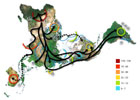 One model of human migration based on mitochondrial DNA (dates in thousands of years). Image: Wikimedia |
Human expansion from Africa comes into focus (Africa) 1 November 2012 A new, comprehensive review of human anthropological and genetic records gives the most up-to-date story of the “Out of Africa” expansion that occurred about 45,000 to 60,000 years ago. This expansion, detailed by three Stanford geneticists Henn, Cavalli-Sforza, and Feldman presents an up-to-date version of the model. In the recent study is published in this edition of the Proceedings of the National Academy of Sciences they conclude it had a dramatic effect on human genetic diversity, which persists in present-day populations. As a small group of modern humans migrated out of Africa into Eurasia and the Americas, their genetic diversity was substantially reduced. Previous genomic projects In studying these migrations, genomic projects haven’t fully taken into account the rich archaeological and anthropological data available, and vice versa. This review integrates both sides of the story and provides a foundation that could lead to better understanding of ancient humans and, possibly, genomic and medical advances. “People are doing amazing genome sequencing, but they don’t always understand human demographic history” that can help inform an investigation, said review co-author Brenna Henn, a postdoctoral fellow in genetics at the Stanford School of Medicine who has a PhD in anthropology from Stanford. “We wanted to write this as a primer on pre-human history for people who are not anthropologists.” “This model of the Out of Africa expansion provides the framework for testing other anthropological and genetic models,” Henn said “The basic notion is that all of these disciplines have to be considered simultaneously when thinking about movements of ancient populations,” said Marcus Feldman, a professor of biology at Stanford and the senior author of the paper. “What we’re proposing is a story that has potential to explain any of the fossil record that subsequently becomes available, and to be able to tell what was the size of the population in that place at that time.” The anthropological information can inform geneticists when they investigate certain genetic changes that emerge over time. For example, geneticists have found that genes for lactose intolerance and gluten sensitivity began to emerge in populations expanding into Europe around 10,000 years ago. The anthropological record helps explain this: It was around this time that humans embraced agriculture, including milk and wheat production. The populations that prospered – and thus those who survived to pass on these mutations – were those who embraced these unnatural food sources. This, said Feldman, is an example of how human movements drove a new form of natural selection. Expanding populations and bottleneck diversity Populations that expand from a small founding group can also exhibit reduced genetic diversity – known as a “bottleneck” – a classic example being the Ashkenazi Jewish population, which has a fairly large number of genetic diseases that can be attributed to its small number of founders. When this small group moved from the Rhineland to Eastern Europe, reproduction occurred mainly within the group, eventually leading to situations in which mothers and fathers were related. This meant that offspring often received the same deleterious gene from each parent and, as this process continued, ultimately resulted in a population in which certain diseases and cancers are more prevalent. “If you know something about the demographic history of populations, you may be able to learn something about the reasons why a group today has a certain genetic abnormality – either good or bad,” Feldman said. “That’s one of the reasons why in our work we focus on the importance of migration and history of mixing in human populations. It helps you assess the kinds of things you might be looking for in a first clinical assessment. It doesn’t have the immediacy of prescribing chemotherapy – it’s a more general look at what’s the status of human variability in DNA, and how might that inform a clinician.” Source : http://www.pasthorizonspr.com/index.php/archives/11/2012/human-expansion-from-africa-comes-into-focus
|
 |
New Stanford analysis provides fuller picture of human expansion from Africa (Africa) 22 October 2012 A comprehensive analysis of the anthropological and genetic history of humans' expansion out of Africa could lead to medical advances. By Bjorn Carey Integrating anthropological information into models can better inform geneticists when they investigate certain genetic changes that emerge over time. (Photo: Bruce Rolff/Shutterstock) A new, comprehensive review of humans' anthropological and genetic records gives the most up-to-date story of the "Out of Africa" expansion that occurred about 45,000 to 60,000 years ago. This expansion, detailed by three Stanford geneticists, had a dramatic effect on human genetic diversity, which persists in present-day populations. As a small group of modern humans migrated out of Africa into Eurasia and the Americas, their genetic diversity was substantially reduced. In studying these migrations, genomic projects haven't fully taken into account the rich archaeological and anthropological data available, and vice versa. This review integrates both sides of the story and provides a foundation that could lead to better understanding of ancient humans and, possibly, genomic and medical advances. "People are doing amazing genome sequencing, but they don't always understand human demographic history" that can help inform an investigation, said review co-author Brenna Henn, a postdoctoral fellow in genetics at the Stanford School of Medicine who has a PhD in anthropology from Stanford. "We wanted to write this as a primer on pre-human history for people who are not anthropologists." This model of the Out of Africa expansion provides the framework for testing other anthropological and genetic models, Henn said, and will allow researchers to constrain various parameters on computer simulations, which will ultimately improve their accuracy. "The basic notion is that all of these disciplines have to be considered simultaneously when thinking about movements of ancient populations," said Marcus Feldman, a professor of biology at Stanford and the senior author of the paper. "What we're proposing is a story that has potential to explain any of the fossil record that subsequently becomes available, and to be able to tell what was the size of the population in that place at that time." The anthropological information can inform geneticists when they investigate certain genetic changes that emerge over time. For example, geneticists have found that genes that allowed humans to tolerate lactose and gluten began to emerge in populations expanding into Europe around 10,000 years ago. The anthropological record helps explain this: It was around this time that humans embraced agriculture, including milk and wheat production. The populations that prospered - and thus those who survived to pass on these mutations - were those who embraced these unnatural food sources. This, said Feldman, is an example of how human movements drove a new form of natural selection. Populations that expand from a small founding group can also exhibit reduced genetic diversity - known as a "bottleneck" - a classic example being the Ashkenazi Jewish population, which has a fairly large number of genetic diseases that can be attributed to its small number of founders. When this small group moved from the Rhineland to Eastern Europe, reproduction occurred mainly within the group, eventually leading to situations in which mothers and fathers were related. This meant that offspring often received the same deleterious gene from each parent and, as this process continued, ultimately resulted in a population in which certain diseases and cancers are more prevalent. "If you know something about the demographic history of populations, you may be able to learn something about the reasons why a group today has a certain genetic abnormality - either good or bad," Feldman said. "That's one of the reasons why in our work we focus on the importance of migration and history of mixing in human populations. It helps you assess the kinds of things you might be looking for in a first clinical assessment. It doesn't have the immediacy of prescribing chemotherapy - it's a more general look at what's the status of human variability in DNA, and how might that inform a clinician." The study is published in the current edition of the Proceedings of the National Academy of Sciences and was co-authored by Feldman's longtime collaborator, population geneticist Luigi Luca Cavalli-Sforza of Stanford and the Università Vita-Salute San Raffaele in Italy. Source : http://news.stanford.edu/pr/2012/pr-genetic-human-evolution-102212.html
|
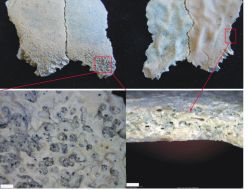 |
Study Suggests Early Humans Ate Meat 1.5 Million Years Ago (Tanzania, East Africa) 3 October 2012 Close examination of a 1.5 million-year-old skull fragment orginally discovered at Olduvai Gorge in Tanzania reveals features that indicate anemia, a nutrional deficiency caused by the lack of vitamin B, a vitamin commonly acquired through the consumption of meat. The discovery was made by an international team of researchers led by Manuel Domínguez-Rodrigo from Complutense University, Madrid, and it suggests that early human ancestors ate meat earlier in history than previously thought. The skull fragment, dated to approximately 1.5 million years B.P. and identified as belonging to a child aged less than two, shows bone lesions that commonly result from a lack of B-vitamins in the diet. Previous studies have indicated that early hominids may have consumed meat, but it was uncertain if they ate meat on a regular basis, or only occasionally. The lesions in the bone fragment suggests, according to the study authors, that meat-eating was common enough that not consuming it could lead to anemia. The child likely could have acquired vitamins associated with meat through the mother's milk before weaning. Nutritional deficiencies such as anemia are most common at weaning, when a child's diet commonly changes. The researchers suggest that the child may have died after starting to eat solid foods lacking meat or, if the child was still breastfeeding, the mother may have been nutritionally deficient because of the lack of meat in her diet. Based on the study results, "early humans were hunters, and had a physiology adapted to regular meat consumption at least 1.5 million years ago", according to the researchers. Source : http://popular-archaeology.com/issue/september-2012/article/study-suggests-early-humans-ate-meat-1-5-million-years-ago
|
 A Hadza hunter in Tanzania. The skills need to kill animals for food have now been dated back to two million years ago. Photograph: Nigel Pavitt/Corbis |
Humans hunted for meat 2 million years ago (Tanzania, East Africa) 23 September 2012 Evidence from ancient butchery site in Tanzania shows early man was capable of ambushing herds up to 1.6 million years earlier than previously thought Ancient humans used complex hunting techniques to ambush and kill antelopes, gazelles, wildebeest and other large animals at least two million years ago. The discovery – made by anthropologist Professor Henry Bunn of Wisconsin University – pushes back the definitive date for the beginning of systematic human hunting by hundreds of thousands of years. Two million years ago, our human ancestors were small-brained apemen and in the past many scientists have assumed the meat they ate had been gathered from animals that had died from natural causes or had been left behind by lions, leopards and other carnivores. But Bunn argues that our apemen ancestors, although primitive and fairly puny, were capable of ambushing herds of large animals after carefully selecting individuals for slaughter. The appearance of this skill so early in our evolutionary past has key implications for the development of human intellect. "We know that humans ate meat two million years ago," said Bunn, who was speaking in Bordeaux at the annual meeting of the European Society for the study of Human Evolution (ESHE). "What was not clear was the source of that meat. However, we have compared the type of prey killed by lions and leopards today with the type of prey selected by humans in those days. This has shown that men and women could not have been taking kill from other animals or eating those that had died of natural causes. They were selecting and killing what they wanted." That finding has major implications, he added. "Until now the oldest, unambiguous evidence of human hunting has come from a 400,000-year-old site in Germany where horses were clearly being speared and their flesh eaten. We have now pushed that date back to around two million years ago." The hunting instinct of early humans is a controversial subject. In the first half of the 20th century, many scientists argued that our ancestors' urge to hunt and kill drove us to develop spears and axes and to evolve bigger and bigger brains in order to handle these increasingly complex weapons. Extreme violence is in our nature, it was argued by fossil experts such as Raymond Dart and writers like Robert Ardrey, whose book African Genesis on the subject was particularly influential. By the 80s, the idea had run out of favour, and scientists argued that our larger brains evolved mainly to help us co-operate with each other. We developed language and other skills that helped us maintain complex societies. "I don't disagree with this scenario," said Bunn. "But it has led us to downplay the hunting abilities of our early ancestors. People have dismissed them as mere scavengers and I don't think that looks right any more." In his study, Bunn and his colleagues looked at a huge butchery site in the Olduvai Gorge in Tanzania. The carcasses of wildebeest, antelopes and gazelles were brought there by ancient humans, most probably members of the species Homo habilis, more than 1.8 million years ago. The meat was then stripped from the animals' bones and eaten. "We decided to look at the ages of the animals that had been dragged there," said Benn. "By studying the teeth in the skulls that were left, we could get a very precise indication of what type of meat these early humans were consuming. Were they bringing back creatures that were in their prime or were old or young? Then we compared our results with the kinds of animals killed by lions and leopards." The results for several species of large antelope Bunn analysed showed that humans preferred only adult animals in their prime, for example. Lions and leopards killed old, young and adults indiscriminately. For small antelope species, the picture was slightly different. Humans preferred only older animals, while lions and leopards had a fancy only for adults in their prime. "For all the animals we looked at, we found a completely different pattern of meat preference between ancient humans and other carnivores, indicating that we were not just scavenging from lions and leopards and taking their leftovers. We were picking what we wanted and were killing it ourselves." Bunn believes these early humans probably sat in trees and waited until herds of antelopes or gazelles passed below, then speared them at point-blank range. This skill, developed far earlier than suspected, was to have profound implications. Once our species got a taste for meat, it was provided with a dense, protein-rich source of energy. We no longer needed to invest internal resources on huge digestive tracts that were previously required to process vegetation and fruit, which are more difficult to digest. Freed from that task by meat, the new, energy-rich resources were then diverted inside our bodies and used to fuel our growing brains. As a result, over the next two million years our crania grew, producing species of humans with increasingly large brains – until this carnivorous predilection produced Homo sapiens. Source : http://www.guardian.co.uk/science/2012/sep/23/human-hunting-evolution-2million-years
|
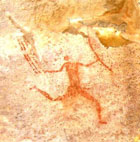 |
Extensive DNA Study Sheds Light on Modern Human Origins (Africa) 20 September 2012 A new study of human genetic variation in sub-Saharan Africa, where modern Homo sapiens are believed to have originated, helps to reveal the region's rich genetic history, with implications for understanding the complexity of early modern human evolution. The largest genomic study ever conducted among the Khoe and San population groups in southern Africa reveals that these groups are descendants of the earliest diversification event in the history of all humans - some 100,000 years ago, well before the largely accepted 'out-of-Africa' migration date range of modern humans. Some 220 individuals from different regions in southern Africa participated in the research, leading to the analysis of around 2.3 million DNA variants per individual – the largest such study ever conducted. The research was conducted by a group of international scientists, including Dr. Carina Schlebusch and Assistant Professor Mattias Jakobsson from Uppsala University in Sweden and Professor Himla Soodyall from the Human Genomic Diversity and Disease Research Unit in the Health Faculty at the University of the Witwatersrand in Johannesburg. "The deepest divergence of all living people occurred some 100,000 years ago, well before modern humans migrated out of Africa and about twice as old as the divergences of central African Pygmies and East African hunter-gatherers and from other African groups," says lead author Dr Carina Schlebusch, a Wits University PhD-graduate now conducting post-doctoral research at Uppsala University in Sweden. According to her colleague Matthias Jakobsson, these deep divergences among African populations have important implications and consequences when the history of all humankind is deciphered. The deep structure and patterns of genetic variation suggest a complex population history of the peoples of Africa. "The human population has been structured for a long time," says Jakobsson, "and it is possible that modern humans emerged from a non-homogeneous group." The study also found surprising stratification among Khoe-San groups. For example, the researchers estimate that the San populations from northern Namibia and Angola separated from the Khoe and San populations living in South Africa as early as 25,000 – 40,000 years ago. "There is astonishing ethnic diversity among the Khoe-San group, and we were able to see many aspects of the colorful history that gave rise to this diversity in their DNA", said Schlebusch. The study further indicates how pastoralism first spread to southern Africa in combination with the Khoe culture. From archaeological and ethnographic studies it has been suggested that pastoralism was introduced to the Khoe in southern Africa before the arrival of Bantu-speaking farmers, but it has been unclear if this event had any genetic impact. The Nama, a pastoralist Khoe group from Namibia showed great similarity to 'southern' San groups. "However, we found a small but very distinct genetic component that is shared with East Africans in this group, which may be the result of shared ancestry associated with pastoral communities from East Africa," says Schlebusch. With the genetic data the researchers could see that the Khoe pastoralists originated from a Southern San group that adopted pastoralism with genetic contributions from an East African group – a group that would have been the first to bring pastoralist practices to southern Africa. The study also revealed evidence of local adaptation in different Khoe and San groups. For example, the researchers found that there was evidence for selection in genes involved in muscle function, immune response, and UV-light protection in local Khoe and San groups. These could be traits linked with adaptations to the challenging environments in which the ancestors of present-day San and Khoe were exposed to that have been retained in the gene pool of local groups. The researchers also looked for signals across the genome of ancient adaptations that happened before the historical separation of the Khoe-San lineage from other humans. "Although all humans today carry similar variants in these genes, the early divergence between Khoe-San and other human groups allowed us to zoom-in on genes that have been fast-evolving in the ancestors of all of us living on the planet today," said Pontus Skoglund from Uppsala University. Among the strongest candidates were genes involved in skeletal development that may have been crucial in determining the characteristics of anatomically modern humans. The researchers are now making the genome-wide data freely available: "Genetic information is getting more and more important for medical purposes. In addition to illuminating their history, we hope that this study is a step towards Khoe and San groups also being a part of that revolution," says Schlebusch. Another author, Professor Mike de Jongh from University of South Africa adds, "It is important for us to communicate with the participants prior to the genetic studies, to inform individuals about the nature of our research, and to also go back to not only share the results with them, but also to explain the significance of the data for recapturing their heritage, to them." Source : http://popular-archaeology.com/issue/september-2012/article/extensive-dna-study-sheds-light-on-modern-human-origins
|
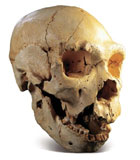 At 500,000 years, the dating of this skull of Homo heidelbergensis clashed with previous DNA dates for Neanderthal origins. J. TRUEBA/MSF/SPL |
Studies slow the human DNA clock (Africa) 18 September 2012 Revised estimates of mutation rates bring genetic accounts of human prehistory into line with archaeological data. The story of human ancestors used to be writ only in bones and tools, but since the 1960s DNA has given its own version of events. Some results were revelatory, such as when DNA studies showed that all modern humans descended from ancestors who lived in Africa more than 100,000 years ago. Others were baffling, suggesting that key events in human evolution happened at times that flatly contradicted the archaeology. Now archaeologists and geneticists are beginning to tell the same story, thanks to improved estimates of DNA’s mutation rate — the molecular clock that underpins genetic dating1–4. “It’s incredibly vindicating to finally have some reconciliation between genetics and archaeology,” says Jeff Rose, an archaeologist at the University of Birmingham, UK. Archaeologists and geneticists may now be able to tackle nuanced questions about human history with greater confidence in one another’s data. “They do have to agree,” says Aylwyn Scally, an evolutionary genomicist at the Wellcome Trust Sanger Institute in Hinxton, UK. “There was a real story.” The concept of a DNA clock is simple: the number of DNA letter differences between the sequences of two species indicates how much time has elapsed since their last common ancestor was alive. But for estimates to be correct, geneticists need one crucial piece of information: the pace at which DNA letters change. Geneticists have previously estimated mutation rates by comparing the human genome with the sequences of other primates. On the basis of species-divergence dates gleaned — ironically — from fossil evidence, they concluded that in human DNA, each letter mutates once every billion years. “It’s a suspiciously round number,” says Linda Vigilant, a molecular anthropologist at the Max Planck Institute for Evolutionary Anthropology in Leipzig, Germany. The suspicion turned out to be justified. In the past few years, geneticists have been able to watch the molecular clock in action, by sequencing whole genomes from dozens of families5 and comparing mutations in parents and children. These studies show that the clock ticks at perhaps half the rate of previous estimates, says Scally. In a review published on 11 September1,Scally and his colleague Richard Durbin used the slower rates to reevaluate the timing of key splits in human evolution. “If the mutation rate is halved, then all the dates you estimate double,” says Scally. “That seems like quite a radical change.” Yet the latest molecular dates mesh much better with key archaeological dates. Take the 400,000–600,000-year-old Sima de Los Huesos site in Atapuerca, Spain, which yielded bones attributed to Homo heidelbergensis, the direct ancestors of Neanderthals. Genetic studies have suggested that earlier ancestors of Neanderthals split from the branch leading to modern humans much more recently, just 270,000–435,000 years ago. A slowed molecular clock pushes this back to a more comfortable 600,000 years ago (see ‘Better agreement over the human story’). A slower molecular clock could also force scientists to re-think the timing of later turning points in prehistory, including the migration of modern humans out of Africa. Genetic studies of humans around the world have suggested that the ancestors of Europeans and Asians left Africa about 60,000 years ago. That date caused many to conclude that 100,000-year-old human fossils discovered in Israel represented a dead-end migration rather than the beginning of a global exodus, says Scally. Scally’s calculations put “out of Africa” closer to 120,000 years ago, suggesting that the Israeli sites represent a launching pad for the spread of humans into Asia and Europe. The latest genetic dates also fit with several sites in the Middle East that contain tools apparently made by modern humans but dating to around 100,000 years ago. At that time, sea levels between Africa and the Arabian Peninsula were lower than they are now, and a wetter climate would have made the peninsula lush and habitable, perhaps beckoning modern humans out of Africa. Rose, who works one such site, in Oman, says that he “has been over the moon” since reading Scally and Durbin’s paper. The revised molecular clock may also help to settle a debate over whether humans ventured further into Asia more than 60,000 years ago, says Michael Petraglia, an archaeologist at the University of Oxford, UK, who favours an early date. Although a slowed molecular clock may harmonize the story of human evolution, it does strange things when applied further back in time, says David Reich, an evolutionary geneticist at Harvard Medical School in Boston, Massachusetts. “You can’t have it both ways.” For instance, the slowest proposed mutation rate puts the common ancestor of humans and orang-utans at 40 million years ago, he says: more than 20 million years before dates derived from abundant fossil evidence. This very slow clock has the common ancestor of monkeys and humans co-existing with the last dinosaurs. “It gets very complicated,” deadpans Reich. Some researchers, including Scally, have proposed that the mutation rate may have slowed over the past 15 million years, thereby accounting for such discrepancies. Fossil evidence suggests that ancestral apes were smaller than living ones, and small animals tend to reproduce more quickly, speeding the mutation rate. Little concrete evidence supports this idea, says Reich. He agrees that the molecular clock must be slower than was thought, but says that the question is how slow. “My strong view right now is that the true value of the human mutation rate is an open question.” Source : http://www.nature.com/news/studies-slow-the-human-dna-clock-1.11431
|
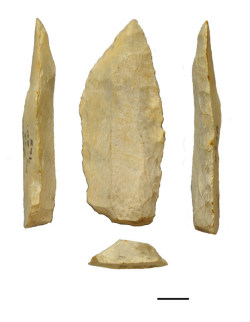 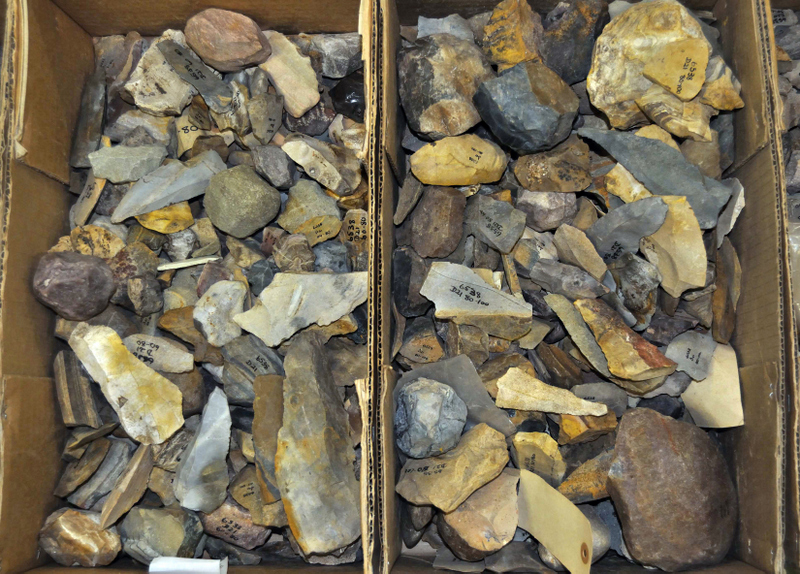 Part of the ~500 thousand-year-old Kathu Pan 1 lithic collection, which is housed at the McGregor Museum, Kimberley, South Africa. [Image courtesy of Jayne Wilkins] |
Stone-Tipped Spears Used Much Earlier Than Thought, Say Researchers (South Africa) 8 September 2012 Evidence from South Africa shows that human ancestors were making stone-tipped spears 500,000 years ago. A University of Toronto-led team of anthropologists has found evidence that human ancestors used stone-tipped weapons for hunting 500,000 years ago - 200,000 years earlier than previously thought. "This changes the way we think about early human adaptations and capacities before the origin of our own species," says Jayne Wilkins, a PhD candidate in the Department of Anthropology at the University of Toronto and lead author of a new study in Science. "Although both Neandertals and humans used stone-tipped spears, this is the first evidence that the technology originated prior to or near the divergence of these two species," says Wilkins. Attaching stone points to spears – known as 'hafting' – was an important advance in hunting weaponry for early humans. Hafted tools require more effort and foreplanning to manufacture, but a sharp stone point on the end of a spear can increase its killing power. Hafted spear tips are common in Stone Age archaeological sites after 300,000 years ago. This new study shows that they were also used in the early Middle Pleistocene, a period associated with Homo heidelbergensis (a hominid species that has been suggest by many scientists to be ancestral to humans) and the last common ancestor of Neandertals and modern humans. "It now looks like some of the traits that we associate with modern humans and our nearest relatives can be traced further back in our lineage", Wilkins says. Wilkins and colleagues from Arizona State University and the University of Cape Town examined 500,000-year-old stone points from the South African archaeological site of Kathu Pan 1 and determined that they had functioned as spear tips. The points were recovered during 1979-1982 excavations by Peter Beaumont of the McGregor Museum. In 2010, a team directed by Chazan reported that the point-bearing deposits at Kathu Pan 1 dated to ~500,000 years ago using optically stimulated luminescence and U-series/electron spin resonance methods. The dating analyses were carried out by Naomi Porat, Geological Survey of Israel, and Rainer Grün, Australian National University. In this latest study of the stone points led by Wilkins, point function was determined by comparing wear on the ancient points to damage inflicted on modern experimental points used to spear a springbok carcass target with a calibrated crossbow. This method has been used effectively to study weaponry from more recent contexts in the Middle East and southern Africa. The stone points exhibit certain types of breaks that occur more commonly when they are used to tip spears compared to other uses. "The archaeological points have damage that is very similar to replica spear points used in our spearing experiment," says Wilkins. "This type of damage is not easily created through other processes." The findings are reported in the paper "Evidence for Early Hafted Hunting Technology" published in the November 16, 2012 issue of Science. Other authors contributing to the study are Benjamin Schoville from Arizona State University, Kyle Brown of the University of Cape Town, and University of Toronto archaeologist Michael Chazan. Funding for the research was provided by the Social Sciences and Humanities Research Council of Canada, the National Science Foundation, and the Hyde Family Foundation. Logistical support came from the South African Heritage Resources Agency and the McGregor Museum, Kimberley, South Africa. Source : http://popular-archaeology.com/issue/september-2012/article/stone-tipped-spears-used-much-earlier-than-thought-say-researchers
|
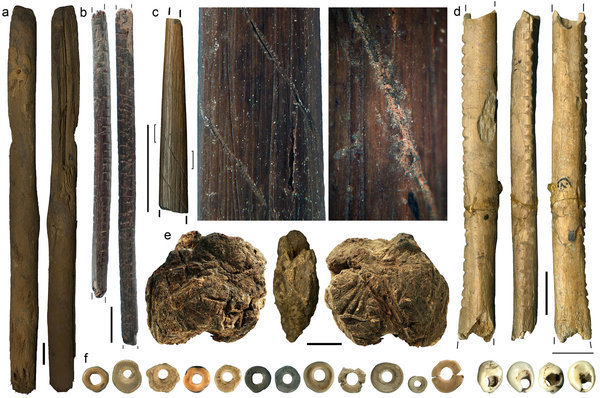 Objects found in the archaeological site called Border Cave include a) a wooden digging stick; b) a wooden poison applicator; c) a bone arrow point decorated with a spiral incision filled with red pigment; d) a bone object with four sets of notches; e) a lump of beeswax; and f) ostrich eggshell beads and marine shell beads used as personal ornaments. (Francesco d'Errico and Lucinda Backwell / July 30, 2012) |
DNA hints at African cousin to humans (Africa) 8 September 2012 Gene profiles suggest people interbred with a now-extinct species on the continent not that long ago Expeditions to Africa may have brought back evidence of a hitherto unknown branch in the human family tree. But this time the evidence wasn’t unearthed by digging in the dirt. It was found in the DNA of hunter-gatherer people living in Cameroon and Tanzania. Buried in the genetic blueprints of 15 people, researchers found the genetic signature of a sister species that branched off the human family tree at about the same time that Neandertals did. This lineage probably remained isolated from the one that produced modern humans for a long time, but its DNA jumped into the Homo sapiens gene pool through interbreeding with modern humans during the same era that other modern humans and Neandertals were mixing in the Middle East, researchers report in the August 3 Cell. The evidence for ancient interbreeding is surprisingly convincing, says Richard “Ed” Green, a genome biologist at the University of California, Santa Cruz. “There is a signal that demands explanation, and archaic admixture seems to be the most reasonable one at this point,” he says. Scientists have discovered that some people with ancestry outside Africa have DNA inherited from Neandertals or Denisovans, a mysterious group known only through DNA derived from a fossil finger bone found in a Siberian cave (SN: 6/5/10, p. 5; SN: 1/15/11, p.10). But those researchers had DNA from fossils to guide their research. This time, researchers led by Sarah Tishkoff at the University of Pennsylvania in Philadelphia didn’t have fossil DNA, or even fossils. Tishkoff’s group took DNA donated by 15 African hunter-gatherers — five Pygmies from Cameroon and five Hadza and five Sandawe from Tanzania— and compiled complete genetic blueprints for each person. Population geneticist Joshua Akey of the University of Washington and his colleagues helped analyze the data. Using a statistical analysis, the team determined that about 2 percent of the DNA from the hunter-gatherers came from an unknown species of hominid that split from modern human ancestors about 1.1 million years ago. These long-lost human cousins must have then interbred with modern humans sometime before the common ancestral lineage of the three hunter-gatherer groups separated about 30,000 to 70,000 years ago, Akey says. A separate study posted online July 23 on arXiv.org examined patterns of single DNA unit changes, known as SNPs, in 22 African groups. That study, by Joseph Pickrell of Harvard Medical School and colleagues, also presents evidence that some African groups, including the Hadza, may harbor DNA from unknown extinct hominids. Other researchers aren’t convinced that the DNA remnants identified are the genetic remains of a new species of human cousin. The DNA could have come from a genetically distinct group of modern humans that has since died out due to changes in their environment, diseases or confrontations with rival groups of humans, says Jean-Jacques Hublin, a paleoanthropologist at the Max Planck Institute for Evolutionary Anthropology in Leipzig, Germany. Relatively recent interbreeding isn’t the only explanation for the presence of this newly discovered DNA, says anthropological geneticist Paul Verdu of Stanford University. He thinks the DNA may be the genetic stamp left by a common ancestor of modern humans and another species. The DNA may have morphed so much in non-African groups, just by chance, that it is now unrecognizable. Source : http://www.sciencenews.org/view/generic/id/342711/title/DNA_hints_at_African_cousin_to_humans
|
|
Malian treasures trapped in a culture war (Mali, West Africa) 25 August 2012 Djenne-Djenno, one of the best-known archaeological sites in sub-Saharan Africa, spreads over several acres of rutted fields near the present city of Djenne in central Mali. The ruts are partly caused by erosion, but they're also scars from decades of digging, by archaeologists in search of history and looters looking for art to sell. When I was there last fall, a few archaeology students were in evidence. These days, with Mali in the throes of political chaos, it's unlikely that anyone is doing much work at all at the site, though history and art are visible everywhere. Ancient pottery shards litter the ground. Here and there the mouths of large clay urns, of a kind once used for food storage or human burial, emerge from the earth's surface, the vessels themselves still submerged. The image of an abandoned battlefield comes to mind, but that's only half-accurate. Physical assaults on Djenne-Djenno may be, at least temporarily, in abeyance. But ethical battles surrounding the ownership of, and right to control and dispose of, art from the past rage on in Africa, as in other parts of the world. A few weeks ago the Museum of Fine Arts, Boston, announced the acquisition of an American private collection of 32 exquisite bronze and ivory sculptures produced in what is now Nigeria between the 13th and 16th centuries. Within days the Nigerian National Commission for Museums and Monuments claimed, via an Internet statement, that the objects had been pillaged by the British military in the late 19th century and should be given back. More chilling were reports last month of cultural property being destroyed in Timbuktu, Mali, some 200 miles north of Djenne. Islamist groups, affiliated with al Qaeda, have singled out Sufism, a moderate, mystical form of Islam widespread in Mali, for attack. In Timbuktu, with its Quranic schools and manuscript libraries, they have begun leveling the tombs of Sufi saints, objects of popular devotion. In short, the wars over art as cultural property take many forms: material, political and ideological. On the surface the dynamics may seem clear cut, the good guys and bad guys easy to identify. In reality the conflicts are multifaceted, questions of innocence and guilt often - though not always - hard to nail down. In many accounts Africa is presented as the acted-upon party to the drama, the loser in the heritage fight, though such is not necessarily the case, and it certainly doesn't have to be, and won't be if we acknowledge Africa as the determining voice in every conversation. At least some of the complications surrounding the story of art found and lost has played out at Djenne-Djenno over the past 35 years. In 1977 the U.S. archaeologists Roderick and Susan McIntosh, husband and wife at the time, began excavating the site and gradually revealed the traces of a sizable settlement. Its origins dated to the third century B.C., but by A.D. 450 it had produced a complex urban society, one that engaged in long-distance trade. The long-held assumption was that both developments came to Africa with the Arab arrival in the seventh and eighth centuries A.D. With new knowledge the continent's past suddenly deepened. And the history of its art was expanded. In the upper strata of the excavation at Djenne-Djenno and at the many related neighboring sites in the Inner Niger Delta archaeologists found terra-cotta sculptures of human and animal figures: men riding horses or entwined by serpents, figures sitting or kneeling, their bodies covered with what looked like blisters or welts. The revelation was finding the sculptures in situ, in their historical context, though the figures themselves were of a familiar type. Numbers of similar terra-cotta sculptures had already been showing up for sale, as tourist souvenirs in Africa and as fine-art collectibles in the West. Source : http://www.sfgate.com/world/article/Malian-treasures-trapped-in-a-culture-war-3815589.php
| |
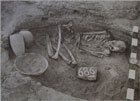 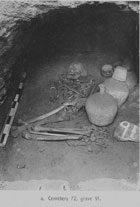 Burial image from Firth (1912) The Archaeological Survey of Nubia. Report for 1908-1909. Cairo, Government Press. Image: The University of Manchester |
New Life for Nubian Bones (Egypt, North Africa) 20 August 2012 A two and a half year transatlantic search by researchers at The University of Manchester for the remains of thousands of Nubian skeletons will culminate in a fascinating workshop later this month. The project has been led by Professor Rosalie David of The University of Manchester and Professor Norman MacLeod of The Natural History Museum. Since 2010 they and a team of researchers, have been identifying the whereabouts of the remains of bodies collected on the first archaeological survey of Nubia more than one hundred years ago. 7,500 skeletons and mummies dating back to between 4,000BC and 1,000AD were excavated during the dig which took place in Southern Egypt from 1907 to 1911. It was a race against time for the American archaeologist, George Reisner, and his team who were battling the rising waters building up behind the newly completed Aswan Low Dam. The fact the area was flooded by the end of the excavation demonstrates the historical importance of what they found and the significance of the Nubian remains that were removed. Scattered around the world However, over the past century the remains have been scattered around the world; placed in various collections where their significance has been lost. Many have also been damaged, including a substantial number of skeletons which were destroyed by a bombing raid in London during the Second World War. Dr Jenefer Cockitt from the Faculty of Life Sciences worked on the project: “We wanted to bring together as many of the remaining skeletons as we could in a virtual database so researchers could properly compare them. We also realised the full potential of these fascinating remains hadn’t been properly fulfilled as research techniques have developed so much since 1911.” Starting with the collection brought back to Manchester by the lead anatomist on the original dig, Sir Grafton Elliot Smith, Dr Cockitt and her colleagues began the painstaking investigation work to identify the bones. They used photos from the dig, notes from the archaeological team, records of the shipments of remains into the UK and identification marks such as the grave number recorded on the bones themselves. They also looked at the very well preserved collection at The Natural History Museum in London. Their investigations eventually led them around the UK and even to America to the Museum of Fine Arts in Boston. Eureka moment Dr Cockitt recalls: “I had a real eureka moment in Cambridge when I found a packet of 400 cards that recorded the details of specific remains. Another high point was in America when we looked through thousands of photos that George Reisner had taken of the dig. It was hard work following the clues but so rewarding when we found what we were looking for. We began to feel that we knew the people behind the bodies and that we were giving them their voice again after all these years. ” Professor MacLeod comments: “In the past, the dispersal of a collection inevitably resulted in the degradation of the collection’s significance and ease of access. But through the use of new technologies collections that physically reside in multiple locations can be brought back together in a virtual sense to support a greater range of scientific investigations than any of the host institutions could provide on its own. This project is a pioneering effort to move collections management into the virtual space and as such will have an influence far beyond the study of Nubian archaeology per se. It also shows what can be accomplished through inter-museum collaboration.” In total Dr Cockitt and her colleagues have identified around 2,000 bodies. The researchers have used modern techniques to re-investigate the remains, focusing on what they can tell us about disease and trauma. Images of the bodies have now been put on a virtual database, bringing them together for the first time since they were removed from the ground more than a hundred years ago. Descriptions of any known pathology or trauma suffered by the individual are recorded, along with a complete dental survey of all bodies with surviving teeth. It should prove to be a significant tool for researchers looking at disease. As the project nears completion, the initial results will be presented at a workshop held at The Natural History Museum, London on the 29 and 30 August, titled “Palaeopathology in Egypt and Nubia: A Century in Review”. The workshop will also bring together researchers from around the world to discuss the history of the discipline in these areas, and what the next steps will be as new and increasingly powerful technologies are brought to bear on the subject. Source : http://www.pasthorizonspr.com/index.php/archives/08/2012/new-life-for-nubian-bones
|
 The Spinx and the Great Pyramid of Giza, Egypt are pictured here. USGS and University of Pennsylvania research shows that ancient pollen and charcoal preserved in deeply buried sediments in Egypt's Nile Delta document the region’s ancient droughts and fires, including a huge drought 4,200 years ago associated with the demise of Egypt's Old Kingdom, the era known as the pyramid-building time. (Credit: Benjamin P. Horton , University of Pennsylvania) |
Climate and Drought Lessons from Ancient Egypt (Egypt, North Africa) 16 August 2012 Ancient pollen and charcoal preserved in deeply buried sediments in Egypt's Nile Delta document the region's ancient droughts and fires, including a huge drought 4,200 years ago associated with the demise of Egypt's Old Kingdom, the era known as the pyramid-building time. "Humans have a long history of having to deal with climate change," said Christopher Bernhardt, a researcher with the U.S. Geological Survey. "Along with other research, this study geologically reveals that the evolution of societies is sometimes tied to climate variability at all scales -- whether decadal or millennial." Bernhardt conducted this research as part of his Ph.D. at the University of Pennsylvania, along with Benjamin Horton, an associate professor in Penn's Department of Earth and Environmental Science. Jean-Daniel Stanley at the Smithsonian Institution also participated in the study, published in July's edition of Geology. "Even the mighty builders of the ancient pyramids more than 4,000 years ago fell victim when they were unable to respond to a changing climate," said USGS Director Marcia McNutt. "This study illustrates that water availability was the climate-change Achilles Heel then for Egypt, as it may well be now, for a planet topping seven billion thirsty people." The researchers used pollen and charcoal preserved in a Nile Delta sediment core dating from 7,000 years ago to the present to help resolve the physical mechanisms underlying critical events in ancient Egyptian history. They wanted to see if changes in pollen assemblages would reflect ancient Egyptian and Middle East droughts recorded in archaeological and historical records. The researchers also examined the presence and amount of charcoal because fire frequency often increases during times of drought, and fires are recorded as charcoal in the geological record. The scientists suspected that the proportion of wetland pollen would decline during times of drought and the amount of charcoal would increase. And their suspicions were right. Large decreases in the proportion of wetland pollen and increases in microscopic charcoal occurred in the core during four different times between 3,000 and 6,000 years ago. One of those events was the abrupt and global mega-drought of around 4,200 years ago, a drought that had serious societal repercussions, including famines, and which probably played a role in the end of Egypt's Old Kingdom and affected other Mediterranean cultures as well. "Our pollen record appears very sensitive to the decrease in precipitation that occurred in the mega-drought of 4,200 years ago," Bernhardt said. "The vegetation response lasted much longer compared with other geologic proxy records of this drought, possibly indicating a sustained effect on delta and Nile basin vegetation." Similarly, pollen and charcoal evidence recorded two other large droughts: one that occurred some 5,000 to 5,500 years ago and another that occurred around 3,000 years ago. These events are also recorded in human history -- the first one started some 5,000 years ago when the unification of Upper and Lower Egypt occurred and the Uruk Kingdom in modern Iraq collapsed. The second event, some 3,000 years ago, took place in the eastern Mediterranean and is associated with the fall of the Ugarit Kingdom and famines in the Babylonian and Syrian Kingdoms. "The study geologically demonstrates that when deciphering past climates, pollen and other micro-organisms, such as charcoal, can augment or verify written or archaeological records -- or they can serve as the record itself if other information doesn't exist or is not continuous," said Horton. This study, Nile delta response to Holocene climate variability, was published in the July edition of Geology, and was authored by Christopher Bernhardt, USGS; Benjamin Horton, Penn; and Jean-Daniel Stanley, Smithsonian Institution. Support for the work came from the University of Pennsylvania, the U.S. Geological Survey, and the Smithsonian Institution. Source : http://www.sciencedaily.com/releases/2012/08/120816110839.htm
|
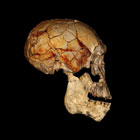 An upper skull found in 1972 and a newly discovered lower jaw are both thought to belong to the enigmatic hominin species Homo rudolfensis. |
Fossils point to a big family for human ancestors (Africa) 8 August 2012 Fossilized skulls show that at least three distinct species belonging to the genus Homo existed between 1.7 million and 2 million years ago, settling a long-standing debate in palaeoanthropology. A study published this week in Nature1 focuses on Homo rudolfensis, a hominin with a relatively flat face, which was first identified from a single large skull in 1972. Several other big-skulled fossils have been attributed to the species since then, but none has included both a face and a lower jaw. This has been problematic: in palaeoanthropology, faces and jaws function like fingerprints for identifying a specimen as a particular species (which is indicated by the second word in a Linnaean title, such as 'rudolfensis'), as opposed to the broader grouping of genus (the first word, as in'Homo'). An upper skull found in 1972 and a newly discovered lower jaw are both thought to belong to the enigmatic hominin species Homo rudolfensis. Without complete skulls, it has been difficult to reach a consensus on whether specimens attributed to H. rudolfensis are genuinely members of a distinct species, or actually belong to other Homo species that lived around the same time, such as Homo habilis or Homo erectus. Understanding how many different Homo species there were, and whether they lived concurrently, would help to determine whether the history of the human lineage saw fierce competition between multiple hominins, or a steady succession from one species to another. But the latest result has dissipated much of this uncertainty. It concerns three fossils — two lower jaws and a juvenile’s lower face — that were found in a desert area called Koobi Fora in northern Kenya. The team that pulled them out of the ground, led by Meave Leakey, a palaeontologist at the Turkana Basin Institute in Nairobi, describes how the dental arcade, the arch created by the teeth at the front of the mouth, is nearly rectangular, just like the palate structure of the 1972 skull. By contrast, the average modern human mouth has a curved dental arcade. Further evidence comes from the juvenile’s face, which tellingly has cheek bones joining the palate quite far forward. “It was such an extended excitement as the juvenile face slowly emerged from the encasing rock, and its similarity to the 1972 specimen became so striking,” recalls Leakey. Yet in many ways, the team’s findings present more questions than answers. One known lower-jaw specimen, dubbed KNM-ER 1802 and widely considered to belong to an individual H. rudolfensis, seems to have a more rounded dental arcade than the latest fossils. This has led Leakey and her colleagues to propose that KNM-ER 1802 belongs to a different Homo species — possibly H. habilis. But until more H. habilis bones are found, the team cannot be sure. “It could be a Homo habilis, but it could also be another species,” says Bernard Wood, a palaeontologist at George Washington University in Washington DC. With as many as four Homo species (H. rudolfensis, H. habilis, H. erectus and whatever KNM-ER 1802 turns out to be) co-existing in one period of evolutionary history, researchers are wondering how different hominins may have behaved in each other's company. “Because the geologic dating is so coarse, we can’t yet be entirely certain that these species were in the same places at the same times," says Wood. "Even so, it is perfectly possible that they were interacting — and if that was so, boy, wouldn’t we like to know what those interactions were like." However, Tim White, a palaeontologist at the University of California, Berkeley, argues that Leakey and her colleagues are putting the cart before the horse. “How can practitioners in this field possibly expect to be able to accurately identify fossil species based upon a few teeth, jaws and lower faces in light of what we know about the great variation found among different individuals in a single living species?” he asks. Leakey stands her ground. “I would challenge Tim to find any primate in which you would see the same degrees of variation as those that we are seeing between our new fossils and KNM-ER 1802," she retorts. Source : http://www.nature.com/news/fossils-point-to-a-big-family-for-human-ancestors-1.11144
|
 An upper skull found in 1972 and a newly discovered lower jaw are both thought to belong to the enigmatic hominin species Homo rudolfensis. |
Multiple Species of Early Homo Lived in Africa (Africa) 8 August 2012 In March, I compiled a list of my top ten hominid fantasy finds. Item number six: more Homo habilis and Homo rudolfensis fossils. The two species are the oldest members of the genus Homo. H. habilis lived roughly 2.4 million to 1.4 million years ago while H. rudolfensis lived about 2 million years ago. But where some scientists see two contemporaneous species, others recognize just one. These researchers say the fossils of H. rudolfensis may simply represent physical variation within the H. habilis species due to differences based on geography or sex. It’s a hard question to answer as there’s only really one good H. rudolfensis fossil. But as it turns out, fantasies really can come true: A team of researchers announced today in Nature that they’ve dug up three new fossils that match the lone H. rudolfensis specimen. The new finds confirm that at least two species of Homo lived in Africa 2 million years ago. In the 1960s, Louis and Mary Leakey discovered the species H. habilis while working at Tanzania’s Olduvai Gorge. In 1972, Bernard Ngeneo, a member of a team led by the Leakeys’ son Richard, discovered a 2-million-year-old skull lacking a lower jaw at Kenya’s Koobi Fora site near Lake Turkana. The skull, known as KNM-ER 1470, sort of looked like H. habilis, but was different in several key ways, such as being much bigger with a flatter face. Some anthropologists suggested the skull belonged to a male H. habilis and that’s why it was bigger. Other researchers said the differences were too great to be explained by sex, and they gave the skull the name H. rudolfensis because Lake Turkana was once known was Lake Rudolf. The three new fossils also come from Koobi Fora, dating to 1.78 million to 1.95 million years ago. They also have a connection to the Leakeys. Meave Leakey, a paleontologist at the Turkana Basin Institute, is married to Richard Leakey, and Louise Leakey, Meave and Richard’s daughter, led the team that made the discoveries. The fossil KNM-ER 62000 is the face of a juvenile. Although much smaller than the KNM-ER 1470 skull, both fossils share the same shape and features. The researchers say this is evidence that H. rudolfensis was a separate species rather than being the male version of H. habilis. The other two fossil finds are of lower jaws, which seem to match the shape of the upper jaws of KNM-ER 1470 and KNM-ER 62000. This further suggests that H. rudolfensis is indeed a separate species because the new jaws are much different from known H. habilis jaws: They are shorter and more rectangular. The team doesn’t outright say that the new fossils plus KMN-ER 1470 should officially be called H. rudolfensis. They’re cautious because of a fossil lower jaw from Olduvai Gorge called OH 7. OH 7 is the type specimen of H. habilis—in other words, it’s the fossil that scientists use to define the species. But the fossil is very distorted. If scientists were to reanalyze the jaw and discover it actually belongs in the same species as the newly found jaws, then by the rules of taxonomy, researchers would have to call that species H. habilis. And then the species we now call H. habilis would need a new name. (Let’s hope that doesn’t happen because it would be very confusing.) Regardless of what the fossils are called, scientists now have much better evidence that two species of Homo lived in Africa at the beginning of the Pleistocene. That number grew to three species with the emergence of Homo erectus 1.89 million years ago. Now there are new questions to ponder. Were H. habilis and H. rudolfensis both dead ends? Did H. erectus descend from one of these species or a currently unknown member of Homo? It looks like I have some new stuff to add to my list of hominid fantasy finds for next year. Source : http://blogs.smithsonianmag.com/hominids/2012/08/multiple-species-of-early-homo-lived-in-africa/
|
|
Malindi archaeologists make new discoveries (Kenya, East Africa) 4 August 2012 Kenyan and Chinese archaeologists yesterday made another major breakthrough in their excavation work after they discovered prisoners’ shackles and spent cartridges at a mass grave in Malindi. The experts described the items as a possible link that indicated there were military activities in Malindi Kingdom and the Kenyan coast. In their latest findings at the site, which had over 15 mammalian skeletons, the archeologists also found skeletons believed to be of wild animals together with those that are human-like. Other discoveries in the ‘mass grave site’ were Indian and Chinese pottery materials, which the excavators said was a clear proof that Malindi had trade links with the Far East during the pre-colonial era. Jambo Haro, the National Museums of Kenya head of archaeology in charge of Coast and Caesar Bita, NMK's head of underwater archaeology, led the excavation team. Haro said the discovery is clear evidence that the skeletons in the trench is not a mass grave but a proof that there were warfare activities. “Today, we have made a major breakthrough in the trench being excavated and cleared out the assumptions that this was a mass grave. In our excavation, we found two shackles (handcuffs) and spent cartridges, a clear indication that the bodies were related to military work,’’ he said. The Archeologist said they could however not ascertain whether the skeletons were those of prisoners of war until further analysis. “There is also pottery materials related to Indians, a clear indication that the Coastal Community traded with the Indians,’’ he said. The site where the mammalian skeletons were found at the Malindi chief’s office is near the Indian Ocean and very close to the former water mark and which has now turned to be a riparian land. Other sites identified include the Malindi Museum and Mamburui which is believed to have existed in the past 1400 years ago. Research being undertaken is aimed to trace Chinese trade links and dubbed the ‘CINO’ Kenya. Mr. Bita said they were expecting to make more discoveries that would help in rewriting the history f Malindi Kingdom and its links to the Far East. He advised locals to tour the sites and learn about the history as it was important not only to the world. Some of the locals who have visited the site were shocked to see such major findings and wondered how the experts chose the location. Source : http://www.the-star.co.ke/news/article-7507/malindi-archaeologists-make-new-discoveries
| |
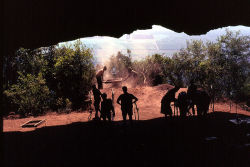 |
A Modern Culture Emerged 44,000 Years Ago (South Africa) 30 July 2012 The emergence of clearly recognizable modern culture in our prehistoric past, as reflected by the observable cultural characteristics of modern hunter-gatherer groups, has long eluded scientists and has been a subject of debate for years. But now, an international team of researchers has uncovered material evidence that indicates a culture, much like that of the modern hunter-gatherer San people of Africa, existed as much as 44,000 years ago. Led by Francesco d'Errico, Director of Research at the French National Research Centre, and a team of scientists that included Lucinda Backwell and Marion Bamford of the University of the Witwatersrand in Johannesburg, South Africa, they have dated and analyzed objects recovered from archaeological strata, or layers, at the Border Cave. Located in the foothills of the Lebombo Mountains in KwaZulu-Natal, South Africa, the site has yielded exceptionally well-preserved organic material, making it well-situated for the application of a variety of time-tested dating techniques. “The dating and analysis of archaeological material discovered at Border Cave in South Africa, has allowed us to demonstrate that many elements of material culture that characterise the lifestyle of San hunter-gatherers in southern Africa, were part of the culture and technology of the inhabitants of this site 44,000 years ago,” says Backwell. Until now, most archaeologists thought that the earliest evidence of San hunter-gatherer culture in southern Africa dates back at most 20,000 years. The artifacts revealed uses and practices very similar to that of modern San applications. Some of them: - Digging sticks weighted with perforated stones, dated to about 44,000 years ago; - A wooden stick decorated with incisions, used to hold and carry a poison containing ricinoleic acid found in castor beans; - Dated to about 40,000 years ago, a lump of beeswax, mixed with the resin of toxic Euphorbia, and possibly egg, wrapped in vegetal fibres made from the inner bark of a woody plant. Like the modern San equivalent, it was likely used for hafting arrowheads or tools; - Warthog tusks shaped into awls and possibly spear heads; and - Small pieces of stone for hunting weapons, confirmed by the discovery of resin residue still adhering to some of the tools, identified as a suberin (waxy substance) produced from the sap of Podocarpus (yellowwood) trees. The similarities did not stop there. Says Backwell, “they adorned themselves with ostrich egg and marine shell beads, and notched bones for notational purposes. They fashioned fine bone points for use as awls and poisoned arrowheads. One point is decorated with a spiral groove filled with red ochre, which closely parallels similar marks that San make to identify their arrowheads when hunting." Another key research team leader, Paola Villa, a curator at the University of Colorado Museum of Natural History and lead study author of another report based on the same research, suggests that the finds indicate that the Later Stone Age thus emerged in South Africa more than 20,000 years earlier than previously believed -- coinciding with the time when humans were migrating from Africa to the European continent. "Our research proves that the Later Stone Age emerged in South Africa far earlier than has been believed and occurred at about the same time as the arrival of modern humans in Europe," said Villa. "But differences in technology and culture between the two areas are very strong, showing the people of the two regions chose very different paths to the evolution of technology and society." Equally telling were the findings regarding the rate and nature of cultural change or evolution. Writes the researchers in their report: "Contrary to lithic technology, which shows at Border Cave a gradual evolution toward the ELSA (Early Later Stone Age) starting after 56 ka, organic artifacts unambiguously reminiscent of LSA (Later Stone Age) and San material culture emerge relatively abruptly, highlighting an apparent mismatch in rates of cultural change. Our results support the view that what we perceive today as modern behavior is the result of nonlinear trajectories that may be better understood when documented at a regional scale". Another key research team leader, Paola Villa, a curator at the University of Colorado Museum of Natural History and lead study author of another report based on the same research, suggests that the finds indicate that the Later Stone Age thus emerged in South Africa more than 20,000 years earlier than previously believed -- coinciding with the time when humans were migrating from Africa to the European continent. "Our research proves that the Later Stone Age emerged in South Africa far earlier than has been believed and occurred at about the same time as the arrival of modern humans in Europe," said Villa. "But differences in technology and culture between the two areas are very strong, showing the people of the two regions chose very different paths to the evolution of technology and society." The research by the team, consisting of scientists from South Africa, France, Italy, Norway, the USA and Britain, is published in two articles online in the prestigious journal, Proceedings of the National Academy of Sciences. The paper titled Early evidence of San material culture represented by organic artifacts from Border Cave, South Africa is authored by Francesco d’Errico, Lucinda Backwell, Paola Villa, Ilaria Degano, Jeannette Lucejko, Marion Bamford, Thomas Higham, Maria Perla Colombini, and Peter Beaumont. The other paper, titled Border Cave and the Beginning of the Later Stone Age in South Africa is authored by Paola Villa, Sylvain Soriano, Tsenka Tsanova, Ilaria Degano, Thomas Higham, Francesco d’Errico, Lucinda Backwell, Jeannette J. Luceiko, Maria Perla Colombini and Peter Beaumont. 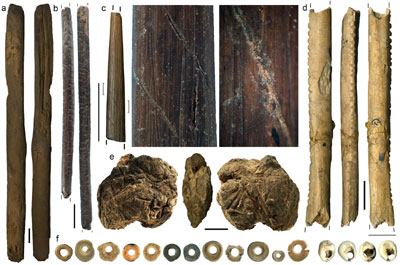 Organic Artefacts from Border Cave a) Wooden digging stick made from Flueggea virosa and dated 40,986 - 38,986 cal BP, b) Wooden poison applicator made from Flueggea virosa dated to 24,564 - 23,941 cal BP and preserving a residue containing poisonous ricinoleic acid found in castor beans, c) Bone arrow point decorated with a spiral incision filled with red pigment, d) Bone object with four sets of notches, each made by a different tool, and probably used for notational purposes, e) Lump of beeswax containing Euphorbia tirucalli resin and possibly egg, bound with vegetal twine and dated 41,167 - 39,194 cal BP, f) Ostrich eggshell beads dated 44,856 - 41,010 cal BP and marine shell beads used as personal ornaments. Scale bars = 1 cm. (IMAGE CREDIT: Francesco d’Errico and Lucinda Backwell) 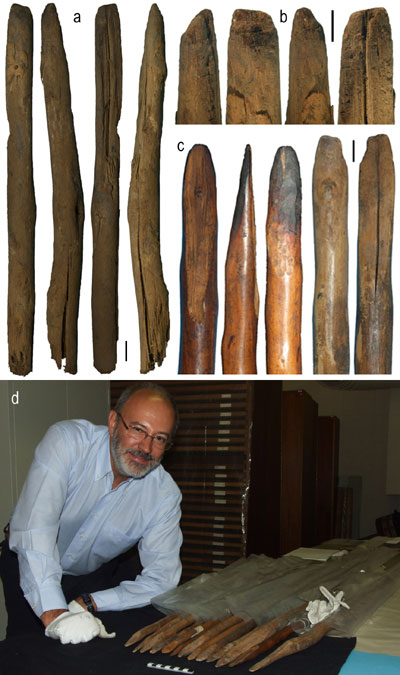 Digging Stick a) Wooden digging stick made from Flueggea virosa and dated 40,986 - 38,986 cal BP, and b) Close up showing rounding and crushing of the tip. c) Kalahari San digging sticks bearing similarity to the Border Cave specimen, d) Francesco d’Errico with San digging sticks from the Fourie Collection (Museum Africa, Johannesburg). Scales = 1 cm. (IMAGE CREDIT: Lucinda Backwell) 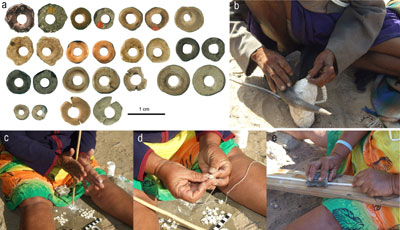 OES Beads Ostrich eggshell beads from Border Cave dated 44,856 - 41,010 cal BP, which show similar production techniques as those used by Kalahari San women, including b) Shaping using a horn and stone anvil, c) Drilling to produce perforations, d) stringing with vegetal twine and e) Smoothing with a grooved stone. (IMAGE CREDIT: Lucinda Backwell) 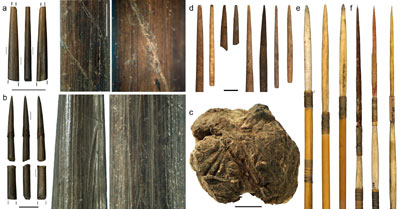
Points and Beeswax a) Bone arrow point decorated with a spiral incision filled with red pigment, b) Bone arrow point shaped by scraping, c) Lump of beeswax containing Euphorbia tirucalli resin and possibly egg, bound with vegetal twine and dated 41,167 - 39,194 cal BP, d) Later Stone Age bone points from South African sites, e) Kalahari San fixed bone arrow heads, and f) Slender poison-encrusted reversible bone arrow heads. Scale bars = 1 cm. (IMAGE CREDIT: Lucinda Backwell) 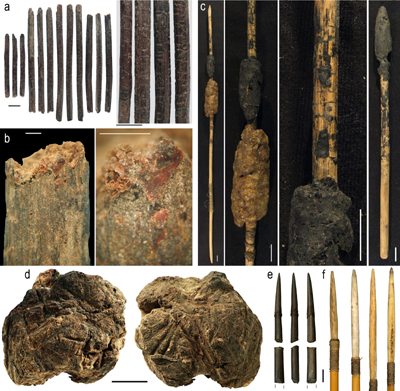
Poison Wax a) Wooden poison applicator from Border Cave made from Flueggea virosa dated to 24,564 - 23,941 cal BP, with close up showing notches, and b) Adhering residue containing poisonous ricinoleic acid found in castor beans. c) Kalahari San poison applicators housed at Museum Africa, Johannesburg, showing lumps of organic compounds used for hafting (yellow) and poisoning (black) arrow points, and the notching to prevent slippage of the material. d) Lump of beeswax from Border Cave containing Euphorbia tirucalli resin and possibly egg, bound with vegetal twine, and dated 41,167 - 39,194 cal BP. e) Bone arrow point from Border Cave and f) Kalahari San fixed bone arrow heads. Scales = 1 cm. (IMAGE CREDIT: Francesco d’Errico and Lucinda Backwell) Source : http://popular-archaeology.com/issue/june-2012/article/modern-culture-emerged-44-000-years-ago
|
 Objects found in the archaeological site called Border Cave include a) a wooden digging stick; b) a wooden poison applicator; c) a bone arrow point decorated with a spiral incision filled with red pigment; d) a bone object with four sets of notches; e) a lump of beeswax; and f) ostrich eggshell beads and marine shell beads used as personal ornaments. (Francesco d'Errico and Lucinda Backwell / July 30, 2012) |
Modern culture emerged in Africa 20,000 years earlier than thought (South Africa) 30 July 2012 Modern culture emerged in southern Africa at least 44,000 years ago, more than 20,000 years earlier than anthropologists had previously believed, researchers reported Monday. That blossoming of technology and art occurred at roughly the same time that modern humans were migrating from Africa to Europe, where they soon displaced Neanderthals. Many of the characteristics of the ancient culture identified by anthropologists are still present in hunter-gatherer cultures of Africa today, such as the San culture of southern Africa, the researchers said. The new evidence was provided by an international team of researchers excavating at an archaeological site called Border Cave in the foothills of the Lebombo Mountains on the border of KwaZulu-Natal in South Africa and Swaziland. The cave shows evidence of occupation by human ancestors going back more than 200,000 years, but the team reported in two papers in the Proceedings of the National Academy of Sciences that they were able to accurately date their discoveries to 42,000 to 44,000 years ago, a period known as the Later Stone Age or the Upper Paleolithic Period in Europe. Among the organic -- and thus datable -- artifacts the team found in the cave were ostrich eggshell beads, thin bone arrowhead points, wooden digging sticks, a gummy substance called pitch that was used to attach bone and stone blades to wooden shafts, a lump of beeswax likely used for the same purpose, worked pig tusks that were probably use for planing wood, and notched bones used for counting. "They adorned themselves with ostrich egg and marine shell beads, and notched bones for notational purposes," said paleoanthropologist Lucinda Backwell of the University of Witwatersrand in South Africa, a member of the team. "They fashioned fine bone points for use as awls and poisoned arrowheads. One point is decorated with a spiral groove filled with red ochre, which closely parallels similar marks that San make to identify their arrowheads when hunting." The very thin bone points are "very good evidence" for the use of bows and arrows, said co-author Paola Villa, a curator at the University of Colorado Museum of Natural History. Some of the bone points were apparently coated with ricinoleic acid, a poison made from the castor bean. "Such bone points could have penetrated thick hides, but the lack of 'knock-down' power means the use of poison probably was a requirement for successful kills," she said. The discovery also represents the first time pitch-making has been documented in South Africa, Villa said. The process requires burning peeled bark in the absence of air. The Stone Age residents probably dug holes in the ground, inserted the bark, lit it on fire, and covered the holes with stones, she said. Source : http://www.latimes.com/news/science/sciencenow/la-sci-sn-modern-culture-africa-20120730,0,4412702.story?track=rss
|
 |
Sudan's Archaeological Sites Threatened by Proposed Dams (Sudan, East Africa) 22 July 2012 In 1999, the construction of the Merowe Dam near the Fourth Nile Cataract — a largely unexplored area whose history of human settlement dates back to the first Kingdom of Kush, sub-Saharan Africa’s earliest urban civilization — resulted in a major international rescue campaign. The project, led by the Sudan Archaeological Research Society and British Museum, lasted a decade and saw archaeologists collect as much information as possible before the dam opened in 2009. Now, faced with three more proposed dams that will flood the Kajbar, Shereiq and Upper Atbara areas along the Nile, Sudan’s archaeologists have again appealed to the international community for help with rescue operations. At a recent meeting in London, international experts met with members of Sudan’s National Corporation for Antiquities and Museums, as well as the Dam Implementation Unit, to “share information and lay the foundation for a large-scale rescue campaign,” according to The Art Newspaper. In the case of the Upper Atbara dam, archaeologists will have three years before flood waters are released. For the Kajbar and Shereiq dams, the estimated window is six years. According to a spokesman from the Dams Implementation Unit, the dams are part of a government plan to “exploit its vast and diverse resources to achieve human welfare by sustainable development” and to “safeguard Sudan’s remaining water share allotted in the 1959 Nile Water Agreement.” He added that his department understands the significance of the endangered archaeological sites and that the unit is “enthusiastic about co-operating with international archaeological bodies.” The Kajbar region, with its hundreds of ancient, medieval and post-medieval sites, appears to be the most widely explored of the three proposed dam areas, but even it remains relatively mysterious. Sabu, for example, a village about 525 kilometers northwest of Khartoum, is known for its Neolithic-era rock-art panels depicting giraffes, New Kingdom ships and Christian churches, but it has yet to be systematically studied by archaeologists. Source : http://popular-archaeology.com/issue/june-2012/article/sudans-archaeological-sites-threatened-by-proposed-dams
|
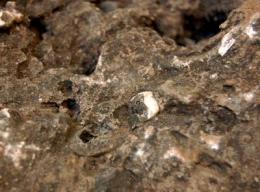 This is the tooth of a hominid embedded in a rock containing significant parts of a skeleton of an early human ancestor. The skeleton is believed to be the remains of "Karabo", the type skeleton of Australopithecus sediba, discovered at the Malapa Site in the Cradle of Humankind in 2009. Credit: University of the Witwatersrand, Johannesburg |
S.African scientists find most complete pre-human skeleton (South Africa) 12 July 2012 South African scientists said Thursday they had uncovered the most complete skeleton yet of an ancient relative of man, hidden in a rock excavated from an archaeological site three years ago. The remains of a juvenile hominid skeleton, of the Australopithecus (southern ape) sediba species, constitute the "most complete early human ancestor skeleton ever discovered," according to University of Witwatersrand palaeontologist Lee Berger. "We have discovered parts of a jaw and critical aspects of the body including what appear to be a complete femur (thigh bone), ribs, vertebrae and other important limb elements, some never before seen in such completeness in the human fossil record," said Berger, a lead professor in the finding. The latest discovery of what is thought to be around two million years old, was made in a one-metre (three-foot) wide rock that lay unnoticed for years in a laboratory until a technician noticed a tooth sticking out of the black stone last month. The technician, Justin Mukanka, said: "I was lifting the block up, I just realized that there is a tooth." It was then scanned to reveal significant parts of an A. sediba skeleton, dubbed Karabo, whose other other parts were first discovered in 2009. Parts of three other skeletons were discovered in 2008 in the world-famous Cradle of Humankind site north of Johannesburg. It is not certain whether the species, which had long arms, a small brain and a thumb possibly used for precision gripping, was a direct ancestor of humans' genus, Homo, or simply a close relative. "It appears that we now have some of the most critical and complete remains of the skeleton," said Berger. Other team members were equally enthusiastic. "It's like putting together the pieces of a puzzle," university laboratory manager Bonita De Klerk told AFP. The skeleton of what has been dubbed Karabo and is thought to date back to around two million years old, would have been aged between nine and 13 years when the upright-walking tree climber died. Remains of four A. sediba skeletons have been discovered in South Africa's Malapa cave, 50 kilometres (30 miles) north of Johannesburg, since 2008. The individuals are believed to have fallen into a pit in the cave and died. The sediba fossils are arguably the most complete remains of any hominids found and are possibly one of the most significant palaeoanthropological discoveries in recent time. The Cradle of Humankind, now a World Heritage Site, is the oldest continuous palaeontological dig in the world. The university also announced it would open up the process of exploring and uncovering fossil remains to the public and stream it online in real time. A special laboratory studio will be built at the Cradle of Humankind. "The public will be able to participate fully in live science and future discoveries as they occur in real time -- an unprecedented moment in palaeoanthropology," said Berger. The lab and the virtual infrastructure are expected to be built within a year, according to Qedani Mahlangu, a regional minister of economic development. The university is in talks with Shanghai Science and Technology Museum in China, Britain's Natural History Museum and the Smithsonian in the United States to set up virtual outposts for the live science project. Source : http://phys.org/news/2012-07-safrican-scientists-pre-human-skeleton.html
|
 An ancient Timbuktu mosque prior to the Islamist takeover of the area (AFP, Francois Xavier Marit) Rescue excavations near Sudan's Merowe Dam in 2004 |
Timbuktu Arabs set up armed watch at ancient tombs (Mali, West Africa) 11 July 2012 BAMAKO — Members of Timbuktu's Arab community said Wednesday they have set up an armed brigade to prevent further destruction of the tombs of ancient Muslim saints by Islamists occupying northern Mali. "Today we have a vigilance brigade so that no one touches the mausolea of Araouane and Gasser-Cheick," said Tahel Ould Sidy, leader of the unit, referring to two tombs in the greater Timbuktu region. "We are armed and there is the required number of people," he added. "We are not going to allow people who know nothing about Islam to come and destroy our treasures. I studied in Mauritania and Saudi Arabia, no one tells us in the Koran that we should destroy tombs." Members of Ansar Dine (Defenders of Faith), an Al-Qaeda-linked armed group which has been in control of northern Mali for over three months, on Tuesday destroyed two tombs in the city's oldest and biggest mosque, Djingereyber. Last week they similarly destroyed seven tombs of ancient Muslim saints as well as the sacred door of another 15th century mosque, all listed as endangered World Heritage sites by UNESCO. They have vowed to destroy all similar sites in the fabled city, which they say are "haram" or forbidden by Islam. A resident of the town said one wall of the Djingareyber mud mosque, built in 1325 according to UNESCO, had partly fallen during the destruction of the tombs. "On Tuesday night the Islamists rapidly rebuilt a part of the grand mosque's wall which fell when they destroyed the two mausolea," he said. Experts say that while moderate Sufi Muslims, the majority in Mali, see the mausolea as shrines, those who follow the radical Wahhabi tradition see them as idolatrous. In their eyes "other veneration is a sort of heresy, a way of stepping away from the oneness of God," said French anthropologist Jean-Claude Penrad. Ansar Dine, along with Al-Qaeda in the Islamic Maghreb and another jihadist offshoot, have controlled vast swathes of northern Mali since a northern takeover by armed groups in the wake of a March 22 coup. Source : AFP : http://www.google.com/hostednews/afp/article/ALeqM5iU96UXIXD4-Czv4Tq39MhCc-rkmQ?docId=CNG.6bcdf8f05326b4ae4bce436a4f2829db.5d1
|
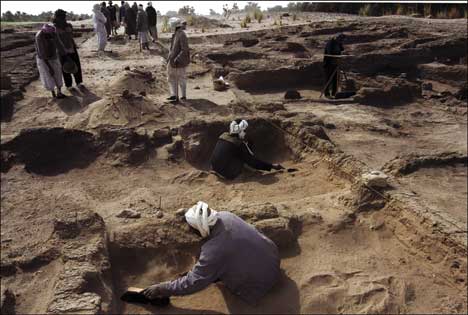 Rescue excavations near Sudan's Merowe Dam in 2004 |
Sudan relics at risk from dam floods. Appeal to archaeological community as proposals leave three- to six-year window (Sudan, East Africa) 10 July 2012 The Sudanese ministry for antiquities is appealing to the international archaeological community to conduct rescue operations to salvage Sudan’s rich archaeological heritage, which is at risk from a series of dams planned in areas including Kajbar, Shereiq and Upper Atbara. The proposed dams will flood various regions along the Nile within three to six years. International experts met representatives from the ministry and the Dams Implementation Unit at the British Museum in London in May to share information and lay the foundation for a large-scale rescue campaign reminiscent of the one mounted more than a decade ago when the Merowe Dam project was under way. One of the meeting’s key outcomes was learning how much time archaeologists have to work before the flooding begins—a simple yet vital question that resulted in much to-ing and fro-ing before those assembled received an answer. It appears that scholars have around three years until flood waters from the Upper Atbara dam are released, and around six years in the case of the Kajbar and Shereiq dams. “These proposed dams will severely damage our cultural heritage,” said Abdelrahman Ali, the director-general of the National Corporation for Antiquities and Museums (NCAM), who opened the meeting with a plea for assistance in salvaging his country’s heritage. Ali was followed by Muawia Mohammed Salih from the Dams Implementation Unit, who said that the dams are part of the government’s plans to “exploit its vast and diverse resources to achieve human welfare by sustainable development” and that it was necessary to “safeguard Sudan’s remaining water share allotted in the 1959 Nile Water Agreement”. He added that his department was aware of the significance of the archaeological sites within the regions to be flooded and that the unit is “enthusiastic about co-operating with international archaeological bodies”. The vast number of archaeological sites within Sudan is a testament to the country’s long and rich history. A survey of the Upper Atbara area by El-Hassan Ahmed Mohammed from the NCAM has recorded at least 40 sites, including prehistoric settlements and cemeteries, 30 of which are in the flood zone. The University of Leicester’s David Edwards, who has worked in northern Sudan’s Third Cataract region for more than 20 years and who has, with Ali Osman Mohammed Salih from the University of Khartoum, recently published a survey of the area, said that there “is certainly no lack of archaeology” in the Kajbar region, noting that there are hundreds of ancient, medieval and post-medieval sites. Of the three “at-risk” regions, Kajbar appears to be the most widely explored by archaeologists. Edwards suggested several areas as a priority for future work in the region, including Arduan Island, which has an extraordinary concentration of pre-Kerma pottery. He also spoke of the academic interest in the region’s rock art, particularly in Sabu. The British Museum’s Derek Welsby noted the fine examples of rock art in Sabu and expressed the need to record and, if possible, remove important examples, especially those on Nubian sandstone that will not withstand the flooding. Although the meeting in London was just the first step in what is sure to be a lengthy and complex campaign, and essential details such as comprehensive maps of the regions to be flooded are still forthcoming, the archaeological community’s desire to help appears to be strong. Ironically, Sudanese cultural heritage may benefit from the political turmoil in countries such as Egypt, Syria, Iran and Iraq, as archaeologists prevented from working in these countries could be diverted to projects in Sudan. Source : http://www.theartnewspaper.com/articles/Sudan-relics-at-risk-from-dam-floods/26797
|
 Modern day Ethiopians show great cultural, linguistic and historical diversity |
DNA clues to Queen of Sheba tale (Ethiopia, East Africa) 21 June 2012 Clues to the origins of the Queen of Sheba legend are written in the DNA of some Africans, according to scientists. Genetic research suggests Ethiopians mixed with Egyptian, Israeli or Syrian populations about 3,000 years ago. This is the time the queen, mentioned in great religious works, is said to have ruled the kingdom of Sheba. The research, published in The American Journal of Human Genetics, also sheds light on human migration out of Africa 60,000 years ago. According to fossil evidence, human history goes back longer in Ethiopia than anywhere else in the world. But little has been known until now about the human genetics of Ethiopians. Professor Chris Tyler-Smith of the Wellcome Trust Sanger Institute in Cambridge, UK, a researcher on the study, told BBC News: "Genetics can tell us about historical events. "By analysing the genetics of Ethiopia and several other regions we can see that there was gene flow into Ethiopia, probably from the Levant, around 3,000 years ago, and this fits perfectly with the story of the Queen of Sheba." This paper sheds light on the very interesting recent and ancient population history of a region that played an important role in both recent and ancient human migration events” Lead researcher Luca Pagani of the University of Cambridge and the Wellcome Trust Sanger Institute added: "The genetic evidence is in support of the legend of the Queen of Sheba." More than 200 individuals from 10 Ethiopian and two neighbouring African populations were analysed in the largest genetic investigation of its kind on Ethiopian populations. About a million genetic letters in each genome were studied. Previous Ethiopian genetic studies have focussed on smaller sections of the human genome and mitochondrial DNA, which passes along the maternal line. Dr Sarah Tishcoff of the Department of Genetics and Biology at the University of Pennsylvania, said Ethiopia would be an important region to study in the future. Commenting on the study, she said: "Ethiopia is a very diverse region culturally and linguistically but, until now, we've known little about genetic diversity in the region. "This paper sheds light on the very interesting recent and ancient population history of a region that played an important role in both recent and ancient human migration events. "In particular, the inference of timing and location of admixture with populations from the Levant is very interesting and is a unique example of how genetic data can be integrated with historical data." The scientists acknowledge that there are uncertainties about dating, with a probable margin of error of a few hundred years either side of 3,000 years. They plan to look at all three billion genetic letters of DNA in the genome of individual Ethiopians to learn more about human genetic diversity and evolution. Source : http://www.bbc.co.uk/news/science-environment-18526428
|
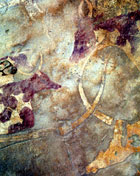 A rock art depiction of domesticated cattle thought to date to between 8,000 and 5,000 years ago comes from a part of the Sahara Desert where chemical evidence now shows that people milked cattle 7,000 years ago. Roberto Ceccacci, © The Archaeological Mission in the Sahara/Sapienza Univ. of Rome |
Archaeological Site in Kenya Opening Window on Early Human Tool-Making (Kenya, East Africa) 20 June 2012 Animal herders living in what was a grassy part of North Africa’s Sahara Desert around 7,000 years ago had a taste for cattle milk, or perhaps milk products such as butter. Researchers have identified a chemical signature of dairy fats on the inside surfaces of pottery from that time. Dairy products played a big part in the diets of these ancient Africans, even though they did not live in farming villages as the earliest European milk users did, reports a team led by biogeochemists Julie Dunne and Richard Evershed, both of the University of Bristol in England. Dairying may have spread from the Middle East and nearby areas — where farming emerged around 10,000 years ago — to Africa and Europe within a couple thousand years, the scientists propose in the June 21 Nature. Chemical evidence shows that cattle milked in the ancient Sahara ate plants from both cool, wet areas and hot, dry expanses. “Animals were being moved around the landscape between different ecosystems containing different plants, possibly as a result of seasonal variations in available pastures,” Evershed says. Researchers generally assume that North Africans domesticated cattle, sheep and goats before growing crops. Previously excavated bones of domesticated animals date to roughly 8,000 years ago in North Africa. Rock paintings in the region depict cattle herding and a few instances of milking, but no reliable dates exist for these artworks. An early date for dairying in North Africa “implies that one of the reasons local African peoples adopted cattle was for their milk products,” says anthropologist Diane Gifford-Gonzalez of the University of California, Santa Cruz. A 2008 pottery study led by Evershed placed the origins of cattle milking in what’s now northwestern Turkey at about 9,000 years ago. Farming, raising animals, dairying and making pottery all apparently spread across Europe at the same time, says anthropologist Kevin Gibbs of the University of Aberdeen, Scotland. In contrast, the new study shows that Saharan herders adopted cattle and dairying into a nomadic lifestyle after having made pottery for several thousand years. Some African groups possess genetic mutations that enable milk drinking without nausea and other unpleasant reactions to lactose, a sugar found in milk. These mutations commonly appear in Europeans, whose farming ancestors used milk at least 6,000 years ago (SN: 2/1/03, p. 67). “We could be looking at multiple origins for dairying,” remarks bioarchaeologist Oliver Craig of the University of York, England. Dunne and Evershed’s group identified different forms of carbon in small, ground-up samples taken from 81 pottery fragments previously found at a Libyan rock shelter and mostly dating to between 7,200 and 5,800 years ago. Each specimen contained carbon with a distinctive signature found in milk fats. Further chemical comparisons to milk fats from grazing animals now living in Africa showed that ancient Saharans milked cattle, but not goats or sheep. Large amounts of dairy fat on the African pottery reflect either good preservation in arid conditions or the use of fat-rich products such as butter that store well and can be digested by lactose-intolerant individuals, Craig says. Source : http://www.sciencenews.org/view/generic/id/341669/title/Ancient_North_Africans_got_milk. by Bruce Bower.
|
|
Archaeological Site in Kenya Opening Window on Early Human Tool-Making (Kenya, East Africa) 13 June 2012 At a site in the Homa Peninsula of Lake Victoria, Kenya, scientists are uncovering stone tools and fossils that are shedding new light on their manufacture and use, as well as early human habitat and behavior. Led by co-directors Dr. Thomas Plummer of Queens College, City University of New York and Dr. Rick Potts of the Smithsonian Institution, excavations at the site, called Kanjera South, have revealed a large and diversified assortment of Oldowan stone tools, fossil animal remains and other flora and faunal evidence that is building a picture of hominin, or early human, life and behavior in a grassland environment about 2 million years ago. Oldowan stone tools represent the earliest known human or hominin stone tool industry, named after the Olduvai Gorge, where Louis Leakey first discovered examples in the 1930's. This early industry was typically composed of simple "pebble tools" such as choppers, scrapers and pounders, a type of technology used from about 2.6 to 1.7 million years ago. According to Plummer, the site "has yielded approximately 3700 fossils and 2900 artifacts.......This represents one of the largest collections of Oldowan artifacts and fauna found thus far". But more significant than the numbers is what the analysis of the finds and the site has revealed. Says Plummer, "the ca. 2.0 Ma sediments at Kanjera South.....provide some of the best early evidence for a grassland dominated ecosystem during the time period of human evolution, and the first clear documentation of human ancestors forming archaeological sites in such a setting". The site thus shows clear evidence that early humans of this time period were inhabiting and utilizing a grassland environment, in addition to other types of environments, a signal of critical adaptation that led to evolutionary success. Moreover, analysis of the makeup of the tools and the geography and geology of the area suggested that these hominins were transporting what they must have consideed to be the highest quality materials from relatively distant locations to produce the most effective and efficient tools for butchering animals. Cut marks made by stone blades on fossil bones, particularly small antelopes, showed signs that the animals may have been hunted, or at least encountered first, by the early humans before other preying animals reached the carcasses. "The overall pattern of hominin access to the complete carcasses of small antelopes may be the signal of hominin hunting", writes Plummer. "If so, this would be the oldest evidence of hunting to date in the archaeological record". Use of stone tools by these early humans apparently went beyond butchery. "Thus far, the use-wear on the quartz and quartzite subsample of Kanjera artifacts confirms that animal butchery was conducted on-site, but also demonstrates the processing of a variety of plant tissues, including wood (for making wooden tools?) and tubers. This is significant, because the processing of plant materials appears to have been quite important, but would otherwise have been archaeologically invisible". Source : http://popular-archaeology.com/issue/june-2012/article/archaeological-site-in-kenya-opening-window-on-early-human-tool-making More information : here
| |
|
Thieves go on a treasure hunt in Egypt, taking advantage of country’s turmoil (Egypt, North Africa) 13 May 2012 Taking advantage of Egypt’s political upheaval, thieves are preying on the country’s ancient pharaonic heritage. Illegal digs near ancient temples and in isolated desert sites have swelled a staggering 100-fold over the past 16 months since a popular uprising toppled Hosni Mubarak’s 29-year regime and security fell apart in many areas as police simply stopped doing their jobs. The pillaging comes on top of a wave of break-ins last year at archaeological storehouses — and even at Cairo’s famed Egyptian Museum, the country’s biggest repository of pharaonic artifacts. Horrified archaeologists and antiquities authorities are scrambling to prevent smuggling, keeping a watch on European and American auction houses in case stolen artifacts show up there. “Criminals became so bold they are digging in landmark areas,” including near the Great Pyramids in Giza, other nearby pyramids and the grand temples of the southern city of Luxor, said Maj. Gen. Abdel-Rahim Hassan, commander of the Tourism and Antiquities Police Department. “It is no longer a crime motivated by poverty. It’s naked greed and it involves educated people,” he said. In a country with more than 5,000 years of civilization buried under its sands, illegal digs have long been a problem. With only slight exaggeration, Egyptians like to joke you can dig anywhere and turn up something ancient, even if its just pottery shards or a statuette. But in the security void, the treasure hunting has mushroomed, with 5,697 cases of illegal digs since the start of the anti-Mubarak uprising in early 2011— 100 times more than the previous year, according to figures obtained by The Associated Press from the Interior Ministry, which is in charge of police. Related crimes have risen as well — 1,467 cases of illicit trading in antiquities and 130 attempts to smuggle antiquities abroad. At least 35 people have been killed in incidents connected to illegal digs, including 10 buried alive in the southern city of Naga Hamadi in March when the hole they dug in the ground caved in. Others were killed in disputes when thieves fell out over sharing the finds, according to Interior Ministry officials familiar with the incidents. They spoke on condition of anonymity because they were not authorized to talk to the press. Those are just the crimes that police uncovered. In their digs, fortune hunters pick spots that are just outside major archaeological sites in hopes that treasures can be found some distance beyond their parameters. Others dig in areas set aside for future excavations by the Supreme Council of Antiquities, Egypt’s top state archaeological agency. Last month, police arrested two men who lived just behind the temple of Khnum in the southern town of Esna for illegally digging under their homes. Police said they found a 10-meter deep hole under the houses with hieroglyphic inscriptions dating to the Ptolemaic dynasty as well as ancient clay pots. Farther south in the Nile-side city of Aswan, police last month arrested a government employee who also dug under his house, uncovering clay pots, an incense urn and tablets bearing images of lotus flowers. The ministry officials said the surge reflects in part the failure of the police to fully take charge of security after they melted away on Jan. 28 last year, after deadly clashes with protesters on the fourth day of the 18-day anti-Mubarak uprising. Since then, many police have been balking at investigating crimes and pursuing criminals, whether out of resentment over the “revolution” or because of the continued lack of strong political authority. The night of Jan. 28, thieves broke into the Egyptian Museum, located on the edge of Tahrir Square, the epicentre of the anti-regime uprising and scene of some of the bloodiest clashes between protesters and Mubarak’s hated police. The robbers made off with 51 pieces that were on display — of which 29 have since been recovered. The most valuable stolen piece, a statue of the Pharaoh Akhenaten, was found by a 16-year-old protester and his family returned it to the museum, the antiquities ministry said at the time. Soon after Mubarak’s Feb, 11, 2011 ouster, the officials said, a Jordanian man was caught trying to smuggle as many as 3,753 artifacts out of Egypt. These, they said, included 48 ancient Egyptian statutes, Roman Age coins and 45 pieces of jewellery dating from the Medieval years of the Islamic era. The months that followed saw a rash of break-ins at antiquity storehouses around the country. “At the end, it’s a question of security,” said Ahmed Mustafa, who until December headed a government department tasked with recovering stolen artifacts. “The robberies of the warehouses took place in broad daylight by armed thieves. Some were raided twice,” said Mr. Mustafa, who now lectures on archaeology at a private Cairo college. One of the largest warehouse thefts took place a year ago in the Sinai city of Qantara, from which roughly 800 artifacts were stolen or damaged by thieves. The pieces, according to regional antiquities chief Mohammed Abdel-Maqsoud, were mostly clay pots, bronze coins and spears dating back to pharaonic and Islamic items. Nearly 300 of these have been recovered, he said. Now that security has been beefed up at most warehouses, thieves have turned to digging. Mansour Bureik, the chief archaeologist in the Luxor area, said there was little chance treasure hunters would run across the gold and gems that they dream of. Those are found only in royal or aristocratic tombs. But Galal Mouawad, a senior archaeologist in the Giza area, said the potential for lucky strikes exist just about anywhere in the country. “Egyptians have over the centuries settled anywhere in Egypt until they have finally settled along the banks of the Nile,” he said. “There is something valuable to be found anywhere.” Source : http://www.theglobeandmail.com/news/world/thieves-go-on-a-treasure-hunt-in-egypt-taking-advantage-of-countrys-turmoil/article2431144/?utm_medium=Feeds%3A%20RSS%2FAtom&utm_source=World&utm_content=2431144
| |
|
Ancient walking gets weirder: Fossils from two human ancestors suggest diversity in gait, stance (Kenya, East Africa) 19 April 2012 PORTLAND, Ore. — The simple act of walking continues to take strange detours among ancient human ancestors. To wit, 1.5 million-year-old footprints excavated in Africa, initially thought to reflect a thoroughly modern walking style, were instead made by individuals that walked differently than people today do, researchers reported April 13 at the annual meeting of the American Association of Physical Anthropologists. And findings presented April 12 at the meeting revealed the surprisingly apelike qualities of foot fossils from a 2 million-year-old species that some researchers regard as the root of the Homo genus. These reports come on the heels of evidence that a previously unknown member of the human evolutionary family 3.4 million years ago possessed a gorillalike grasping big toe and an ungainly stride (SN Online: 3/28/12). Depth measurements of the African footprints, discovered at Kenya’s Ileret site, differ at 10 landmarks from the footprints of people who live in that area today, said graduate student Kevin Hatala of George Washington University in Washington, D.C. “We can infer that the ancient Ileret individuals had a normal, functional gait, but they may have walked differently than we do,” Hatala said. For now, it’s uncertain just how these hominids walked and whether they belonged to Homo erectus, a possibly direct human ancestor, or to the side-branch species Paranthropus boisei. Technologies that produce 3D images of footprints preserved in different types of soil should soon yield insights into how hominids walked at Ileret and at other ancient sites, commented graduate student Sarita Morse of the University of Liverpool in England. Hatala and his colleagues compared five preserved Ileret footprints to those of 38 Daasanach herders in Kenya, none of whom wear shoes. Participants walked across a pressure pad before walking across moistened Ileret soil that approximated the conditions under which the ancient footprints were made. Pressure measurements at 10 spots across the bottom of the foot closely corresponded to depth measurements at the same spots on volunteers’ footprints. Disparities in depth measurements between Daasanach and ancient Ileret footprints signaled that the hominids walked unlike people today do. Other comparisons to Daasanach footprints indicated that two sets of Ileret tracks were made by individuals who were walking, not running, and who stood about 5 feet, 6 inches tall and weighed 110 pounds. That’s in the general size range of Daasanach people today. Meanwhile, new analyses of foot bones from two partial Australopithecus sediba skeletons, excavated in South Africa (SN: 5/8/10, p. 14), show that this hominid had an upwardly curved, mobile mid-foot built for tree-climbing, reported anthropologist Jeremy DeSilva of Boston University. Previous work had identified thin, apelike heels combined with humanlike ankles and arches in these fossil skeletons. “This is a really weird foot,” DeSilva said. “Diversity in upright stances must have extended for a long time during hominid evolution.” Source : http://www.sciencenews.org/view/generic/id/339950/title/Ancient_walking_gets_weirder
| |
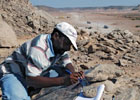 Emergency in Wadi Abu Subeira: Adel Kamel of the Supreme Council of Antiquities in Aswan recording Late Palaeolithic rock art. In the background: Heavy trucks transporting clay from the numerous mines in the wadi. The clay is used in the Egyptian ceramics industry. Photo: Per Storemyr  This superbly made auroch is part of the Late Palaeolithic rock art in Subeira 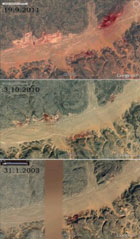 The development in iron mining as seen through Google Earth 2003-2011  Wadi Abu Subeira - a zone of heavy industry |
Wadi Abu Subeira, Egypt: Palaeolithic rock art on the verge of destruction (Egypt, North Africa) 6 April 2012 In 2006 one of the most important recent archaeological discoveries in Egypt were made in Wadi (Chor) Abu Subeira near Aswan: A team led by Adel Kelany of the Supreme Council of Antiquities (SCA) found a stunning assemblage of petroglyphs dating to the Late Palaeolithic era (c. 15-20.000 years ago). Ongoing surveys have shown that the initial find was the tip of the iceberg only, which makes Subeira perhaps the richest place of “Ice-Age” art in North Africa, comparable to the site of Qurta, 50 km to the north. Unfortunately, the Subeira rock art is extremely threatened by modern mining, which lately has proven to be even more widespread than previously thought: A truly unique testimony of mankind’s early art is now on the verge of destruction. The rock art 15-20.000 years ago the waters of the Nile were much higher than today. The broad Wadi Abu Subeira may have been a small “fjord”, reaching several kilometres into the Eastern Desert: A great habitat for wildlife in the otherwise hyperarid environment and a great place for humans to stay – to fish and hunt – and to access the interior of the desert and perhaps the Red Sea. It seems that it was along this “fjord” that the Late Palaeolithic humans made their art. They pecked many aurochs (wild ox), hartebeest, fish, hippopotami and even a very large, beautifully executed Nubian ibex, which publication is forthcoming. Over the millennia erosion along the slopes of the wadi has probably destroyed many pictures, and most are now found on boulders and slabs. However, some are still in-situ, implying that it is possible to reconstruct site distribution. The rock art is comparable to the better-known occurrences at Qurta by Kom Ombo, where Dirk Huyge and his Belgian team has recently confirmed the age of this type of rock art: It is definitely belonging to the Late Palaeolithic era, and thus comparable to the great “Ice-Age” art in Europe – especially in the Late Magdalenian period. It is yet entirely unclear whether there is a relationship in terms of long-distance influence and intercultural contact, but, according to Huyge, the Egyptian occurrences clearly “introduce a new set of challenges to archaeological thought”. This is why it is so important to safeguard the Wadi Abu Subeira rock art and the associated archaeological sites for the future – otherwise we will lose an important place that may help us finding out whether there was in fact contact between North Africa and Europe in the Late Palaeolithic. The mineral wealth – the threats Wadi Abu Subeira was not only a place to fish and hunt and make rock art – it was also a place of great mineral wealth for ancient peoples. The slopes of the wadi feature massive amounts of silicified sandstone (quartzite), which was used for making tools as far back as the Early Palaeolithic. The stone was superior for making grinders, an activity that may have started in the Late Palaeolithic, which saw the small beginnings of “protoagriculture” – the systematic collection and processing of wild plants. For this grinding stone was needed! Also, like the rest of the Aswan region, Wadi Abu Subeira is very rich in iron ore – hematite and ochre. When ground to pigment, Palaeolithic (and later) humans made heavy use of the wonderful red colour, such as for body painting. It is thus very likely that the Subeira hematite and ochre deposits were exploited already in the Palaeolithic. A great gift for ancient man, hematite and ochre is the curse for Adel Kelany and his archaeological team attempting to survey and protect the rich archaeology of Wadi Abu Subeira. For there is still a big need for red pigments, and hematite and ochre can, of course, be made into steel! Lately, the iron mining in the wadi has greatly intensified, seemingly after new concessions were given to various companies by the Egyptian mining authorities (see map above). The new concessions are so extensive that they may effectively wipe out nearly all archaeology from the wadi – as if the wadi was not threatened enough from other mining activities! For, until recently, the greatest risk was related to widespread clay mining for the Egyptian ceramics industry. However, since the clay is occurring in thin layers only, most of the work was undertaken as underground mining, following these thin layers. This mode of mining caused some destruction by the mine openings, but did not wipe out everything nearby. Survey and protection Adel Kelany and his team has until recently been able to deal with the clay mining companies, working together with them to ensure as little destruction of archaeology as possible. Many archaeological sites are also guarded by SCA-personnel and some are fenced off – all to avoid both mining attempts and robbery. As we all know, in the wake of the Egyptian revolution last year, robbery at archaeological sites has skyrocketed because of the security vacuum that developed, and which still is a big problem. But it is more difficult to deal with large-scale iron mine concessions, though Kelany and his SCA team is in constant dialogue with the companies and various authorities to show them the locations of the archaeological sites, trying to persuade them to stop – or not start – working in the vicinity of such sites. They have the strong Egyptian antiquities law behind them, but in view of economic interests it is hugely difficult to enforce the law – not only in Egypt! At the moment we can only hope that Adel Kelany and SCA will be successful in their protection attempts, offering them the moral and other support they may need. But these are very difficult times in Egypt, with administration and political organisation in a relatively chaotic state, and presidential elections soon coming up. As more information about the situation appears, I will keep watching it at this website. Fingers crossed for one of the most significant archaeological sites in Egypt. Literature and internet resources - Storemyr, P., Kelany, A., Negm, M. A., Tohami, A. (2008). More “Lascaux along the Nile”? Possible Late Palaeolithic rock art in Wadi Abu Subeira, Upper Egypt. Sahara, 19, 155-158. PDF (0,5 MB). - Kelany, A. In press. More Late Palaeolithic rock art at Wadi Abu Subeira, Upper Egypt. Annales du Service des Antiquites de l’Egypte. - Dirk Huyge, Dimitri A.G. Vandenberghe, Morgan De Dapper, Florias Mees, Wouter Claes and John C. Darnell, 2011. First evidence of Pleistocene rock art in North Africa: securing the age of the Qurta petroglyphs (Egypt) through OSL dating. Antiquity, 85, 330: 1184–1193. Source : http://per-storemyr.net/2012/04/06/wadi-abu-subeira-egypt-palaeolithic-rock-art-on-the-verge-of-destruction/
|
 Nile crocodile manipulating a carcass of a cow prior to ingestion at a crocodile farm in Bagamoyo, Tanzania. Sharp, pointed teeth can inflict deep grooves with V-shaped cross sections that mimic cut marks. Credit: Courtesy of J.K. Njau |
Cutting through ancient evidence of human tool use (East Africa) 6 April 2012 The earliest evidence of human tool use may be written on the bones of other animals, but in order to produce reliable conclusions, researchers are calling for improved tools and analysis, including an easy-to-access large collection of sample specimens and more unified standards. Archaeologists and anthropologists look beyond the fossils of ancient human relatives to interpret the presence of our ancestors, including the items associated with day-to-day life, from discarded tools to the ashes from fire pits. The marks made by crude stone cutting tools on the bones of animals that early humans ate are another piece of evidence. These markings have tremendous impact on the understanding of human evolution. "Most of our interpretations of what early humans were doing depend on correctly identifying what they were doing on bones," said Manuel Dominguez-Rodrigo, an anthropologist and archaeologist at the Complutense University of Madrid, in Spain. "Detecting exactly how these marks were made on the bones is what makes us grant support to one model of human evolution or a different model of human evolution." These types of bone marks are difficult to interpret. Cutting tools leave marks on bones, but so can other factors, including other predators' teeth and weathering. This has led to notable disagreements about individual bone markings; one finding would, if verified, push back the date of the earliest known human tool use by almost a million years. In 2010, a research group claimed that 3.4 million-year-old fossil bones found in Ethiopia showed evidence of cutting-tool use. Dominguez-Rodrigo and colleagues published months later claiming that trampling of the bones caused the marks. The Olduvai Gorge site, also located in Ethiopia, is generally accepted as the location where the oldest tools -- about 2.6 million years old -- were found. However, some of the markings of bones found at that site are disputed. For decades, researchers have scoured sites in Africa for both marked bones and ancient tools. They have also been experimenting on and collecting the bones of prey animals in order to better understand the effects of many factors, from the biting and tearing of a feeding crocodile to chemical processes. "Butchery marks are as important as stone tools," said Jackson Njau, a paleoanthropologist at Indiana University in Bloomington and an associate researcher at the Stone Age Institute. "But stone tools are rocks; they don't decay." Writing in this week's issue of Science, Njau calls for measures to help scientists make consistent, reliable determinations of the causes of marks. Njau said that one aspect of the solution would be gathering together a large online collection of samples for making comparisons. He has made extensive efforts to document the marks left by crocodile teeth, which can create patterns similar to those made by stone tools. Because marks that look superficially similar reveal crucial differences under a microscope, researchers must compare a new mark to numerous others before making a firm determination of its origin. If large collections now held by different researchers and museums were available in an online database of microscopic images, researchers could instantly access images of bones modified by many processes, such as the chewing action of different carnivores or cuts and slices made by researchers recreating butchery techniques with ancient-style tools. "That would certainly be helpful," said Pat Shipman, a now-retired anthropologist who in 1981, published one of the first papers on microscopic analysis of bone markings. "How big your comparative sample is and how varied it is and how varied the conditions to which the bone was subjected all influences your ability to make a diagnosis of that mark." Dominguez-Rodrigo said that Njau's ideas could help, but would not completely solve the issues. He emphasized that looking at published photographs cannot convey the same knowledge as looking through a microscope at many bones deformed in a wide variety of ways. "Nothing replaces doing the experimentation," said Dominguez-Rodrigo. "The subtleties are hard to capture and describe," said Shipman. "You do have to get that gut-level intuitive feel for it." Njau said that comparisons are important, but also the criteria used by researchers. He emphasized the need for considering the contextual information of a bone marking in its interpretation so that additional indications of the history surrounding the fossil can be considered. He said that scientists must weigh additional factors when analyzing bones for evidence of tool use, including the presence in the same soil layer of stone artifacts, carnivore activity and other factors. "We have these resources, it's time now to put this together to make it available," said Njau. Source : http://phys.org/news/2012-04-ancient-evidence-human-tool.html
|
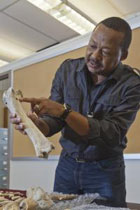 Jackson Njau points to marks on a fossil bone. |
Analytical standards needed for 'reading' Pliocene bones (East Africa) 5 April 2012 BLOOMINGTON, Ind. -- Researchers studying human origins should develop standards for determining whether markings on fossil bones were made by stone tools or by biting animals, Indiana University faculty member Jackson Njau writes in an article this week in the journal Science. Njau, a co-director of field research at paleontological sites in eastern Africa's Olduvai Gorge, notes that the lack of agreement on interpreting such marks is leading to great uncertainty over when early hominids began using tools to kill and butcher animals -- a fundamental step in human evolution. "There's really no solid, standard method of analyzing these bones that is used by all researchers," he said. "And there is no universal guide, nothing that is part of one's training as a student, that tells you reliably how to judge one type of mark from another." Njau joined the faculty of the IU Bloomington Department of Geological Sciences in the College of Arts and Sciences as an assistant professor in the fall. He also is a research associate with Stone Age Institute in Bloomington and the Center for Research into the Anthropological Foundations of Technology at IU. He is former principal curator of the National Natural History Museum in Arusha, Tanzania. His Science Perspectives article, published in the April 6 issue and titled "Reading Pliocene Bones," contends that the "way forward" is through further experimentation, integration of different disciplines to better understand the fossil record, and blind testing of bone samples by researchers and students. He proposes creating a comprehensive collection of samples, developed from experiments on various forms of bone modification, and making it available to researchers and students through the sharing of samples and the posting of photographs and information online. Njau points out that the lack of standard criteria has produced estimates of the earliest use of stone tools that vary by nearly 1 million years. The consensus is that the earliest evidence of tools associated with butchered bones come from Gona, Ethiopia, 2.6 million years ago, discoveries published by Sileshi Semaw of the Stone Age Institute and others. But a 2010 paper argued that 3.4-million-year-old fossil bones from Dikika, Ethiopia, showed tool markings, an interpretation that has been challenged by other research groups. Generally used criteria describe tool marks as V-shaped cuts containing microscopic striations. Percussion marks made by stone hammers are said to consist of pits and grooves, also with micro-striations. But Njau has shown through experiments that the sharp teeth of crocodiles can inflict a range of bite marks closely mimicking tool marks. This suggests that researchers need to rely on more than the appearance of Pliocene and early Pleistocene bones to determine whether they were marked by stone tools, he says. It's also important to consider the quality of the samples and the context in which they were found. For example, how many bones show what appear to be tool marks? Have stone tools been found in the same area and from the same time? Were crocodiles or other animals present that could have caused the marks? Source : http://www.eurekalert.org/pub_releases/2012-04/iu-asn040412.php
|
 This is a panoramic view of the entrance to Wonderwerk Cave, South Africa. |
Scientists find evidence that human ancestors used fire one million years ago, 300,000 years earlier than believed (South Africa) 2 April 2012 An international team led by the University of Toronto and Hebrew University has identified the earliest known evidence of the use of fire by human ancestors. Microscopic traces of wood ash, alongside animal bones and stone tools, were found in a layer dated to one million years ago at the Wonderwerk Cave in South Africa. "The analysis pushes the timing for the human use of fire back by 300,000 years, suggesting that human ancestors as early as Homo erectus may have begun using fire as part of their way of life," said U of T anthropologist Michael Chazan, co-director of the project and director of U of T's Archaeology Centre. The research will be published in the Proceedings of the National Academy of Sciences on April 2. Wonderwerk is a massive cave located near the edge of the Kalahari where earlier excavations by Peter Beaumont of the McGregor Museum in Kimberley, South Africa, had uncovered an extensive record of human occupation. A research project, co-directed by U of T's Chazan and Liora Kolska Horwitz of Hebrew University, has been doing detailed analysis of the material from Beaumont's excavation along with renewed field work on the Wonderwerk site. Analysis of sediment by lead authors Francesco Berna and Paul Goldberg of Boston University revealed ashed plant remains and burned bone fragments, both which appear to have been burned locally rather than carried into the cave by wind or water. The researchers also found extensive evidence of surface discoloration that is typical of burning. "The control of fire would have been a major turning point in human evolution," says Chazan. "The impact of cooking food is well documented, but the impact of control over fire would have touched all elements of human society. Socializing around a camp fire might actually be an essential aspect of what makes us human." The funding for the research was provided by the Social Sciences and Humanities Research Council of Canada, the National Science Foundation and the Wenner Gren Foundation. Other team members include James Brink and Sharon Holt of the National Museum, Bloemfontein, Marion Bamford of the University of Witswatersrand, and Ari Matmon and Hagai Ron of Hebrew University. Research at Wonderwerk Cave is carried out in collaboration with the McGregor Museum, Kimberley and under permit for the South African Heritage Resources Agency. Source : http://www.eurekalert.org/pub_releases/2012-04/uot-sfe_1032812.php
|
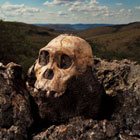 New human species from South Africa — Australopithecus sediba — has been held up as the ancestor of our genus, Homo. Image: Brent Stirton/Getty Images |
First of Our Kind: Could Australopithecus sediba Be Our Long Lost Ancestor? (Africa, Southern Africa) April 2012 Sensational fossils from South Africa spark debate over how we came to be human In brief: The origin of our genus, Homo, is one of the biggest mysteries facing scholars of human evolution. Based on the meager evidence available, scientists have surmised that Homo arose in East Africa, with Lucy’s species, Australopithecus afarensis, giving rise to the founding member of our lineage, Homo habilis. Recently discovered fossils from a site northwest of Johannesburg, South Africa, could upend that scenario. The fossils represent a previously unknown species of human with an amalgam of australopithecine and Homo traits that suggest to its discoverers that it could be the ancestor of Homo. Sometime between three million and two million years ago, perhaps on a primeval savanna in Africa, our ancestors became recognizably human. For more than a million years their australopithecine predecessors—Lucy and her kind, who walked upright like us yet still possessed the stubby legs, tree-climbing hands and small brains of their ape forebears—had thrived in and around the continent’s forests and woodlands. But their world was changing. Shifting climate favored the spread of open grasslands, and the early australopithecines gave rise to new lineages. One of these offshoots evolved long legs, toolmaking hands and an enormous brain. This was our genus, Homo, the primate that would rule the planet. For decades paleoanthropologists have combed remote corners of Africa on hand and knee for fossils of Homo’s earliest representatives, seeking to understand the details of how our genus rose to prominence. Their efforts have brought only modest gains—a jawbone here, a handful of teeth there. Most of the recovered fossils instead belong to either ancestral australopithecines or later members of Homo—creatures too advanced to illuminate the order in which our distinctive traits arose or the selective pressures that fostered their emergence. Specimens older than two million years with multiple skeletal elements preserved that could reveal how the Homo body plan came together eluded discovery. Scientists’ best guess is that the transition occurred in East Africa, where the oldest fossils attributed to Homo have turned up, and that Homo’s hallmark characteristics allowed it to incorporate more meat into its diet—a rich source of calories in an environment where fruits and nuts had become scarce. But with so little evidence to go on, the origin of our genus has remained as mysterious as ever. Source : http://www.scientificamerican.com/article.cfm?id=first-of-our-kind
|
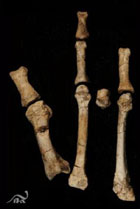 The Burtele partial foot (BRT-VP-2/73). A laboratory photo after cleaning and preparation. It is shown here in its anatomically articulated form. (Credit: © The Cleveland Museum of Natural History Photo courtesy: Yohannes Haile-Selassie) |
'Lucy' Lived Among Close Cousins: Discovery of Foot Fossil Confirms Two Human Ancestor Species Co-Existed (Ethiopia, East Africa) 28 March 2012 A team of scientists has announced the discovery of a 3.4 million-year-old partial foot from the Woranso-Mille area of the Afar region of Ethiopia. The fossil foot did not belong to a member of “Lucy’s” species, Australopithecus afarensis, the famous early human ancestor. Research on this new specimen indicates that more than one species of early human ancestor existed between 3 and 4 million years ago with different methods of locomotion. The analysis will be published in the March 29, 2012 issue of the journal Nature. The partial foot was found in February 2009 in an area locally known as Burtele. “The Burtele partial foot clearly shows that at 3.4 million years ago, Lucy’s species, which walked upright on two legs, was not the only hominin species living in this region of Ethiopia,” said lead author and project leader Dr. Yohannes Haile-Selassie, curator of physical anthropology at The Cleveland Museum of Natural History. “Her species co-existed with close relatives who were more adept at climbing trees, like ‘Ardi’s’ species, Ardipithecus ramidus, which lived 4.4 million years ago.” The partial foot is the first evidence for the presence of at least two pre-human species with different modes of locomotion contemporaneously living in eastern Africa around 3.4 million years ago. While the big toe of the foot in Lucy’s species was aligned with the other four toes for human-like bipedal walking, the Burtele foot has an opposable big toe like the earlier Ardi. “This discovery was quite shocking,” said co-author and project co-leader Dr. Bruce Latimer of Case Western Reserve University. “These fossil elements represent bones we’ve never seen before. While the grasping big toe could move from side to side, there was no expansion on top of the joint that would allow for expanded range of movement required for pushing off the ground for upright walking. This individual would have likely had a somewhat awkward gait when on the ground.” The new partial foot specimen has not yet been assigned to a species due to the lack of associated skull or dental elements. The fossils were found below a sandstone layer. Using the argon-argon radioactive dating method, their age was determined to be younger than 3.46 million years, said co-author Dr. Beverly Saylor of Case Western Reserve University. “Nearby fossils of fish, crocodiles and turtles, and physical and chemical characteristics of sediments show the environment was a mosaic of river and delta channels adjacent to an open woodland of trees and bushes,” said Saylor. “This fits with the fossil, which strongly indicates a hominin adapted to living in trees, at the same time ‘Lucy’ was living on land.” Source : http://www.sciencedaily.com/releases/2012/03/120328135930.htm Journal Reference: Yohannes Haile-Selassie, Beverly Z. Saylor, Alan Deino, Naomi E. Levin, Mulugeta Alene, Bruce M. Latimer. A new hominin foot from Ethiopia shows multiple Pliocene bipedal adaptations. Nature, 2012; 483 (7391): 565 DOI: 10.1038/nature10922
|
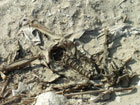 A mummy torn open in search of artefacts lies in shredded wrapping. Image: provided by Dr. Carol Redmount 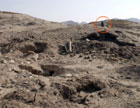 A group of looted tombs with one of the gang (circled) on lookout. Image: provided by Dr. Carol Redmount 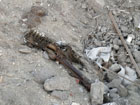 Tossed down a slope, this ransacked mummy is left for the dogs. Image: provided by Dr. Carol Redmount 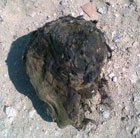 Mummy head ripped from the body and thrown aside. Image: provided by Dr. Carol Redmount |
Massive looting at El Hibeh, Egypt (Egypt, North Africa) 13 March 2012 El Hibeh archaeological site on the east bank of the Nile lies in a particularly impoverished area of Egypt, three hour’s drive south of Cairo. For the past 9 months a gang has been systematically and openly looting the site while the local police seemingly turn a blind eye. The remains at the site date from the late Pharaonic, Graeco-Roman, Coptic and early Islamic periods – approximately 11th century BCE to eighth century CE. El Hibeh is of special importance because it is one of very few relatively intact town sites remaining in Egypt. It contains extensive archaeological deposits dating to the Third Intermediate Period, Egypt’s last “Dark Age” and an era particularly poorly known archaeologically. Dr. Carol Redmount, an eminent archaeologist based at the University of California, Berkeley, arrived in Egypt in February to continue her archaeological work at the site after obtaining permission from Egypt’s Supreme Council of Antiquities which controls all excavations in the country. However, twenty-four hours before departing for the site her permits were revoked by the provincial police service with no explanation. Inquiries revealed that a mafia-like gang led by an escaped criminal has been ruthlessly looting the site since at least June 2011. Dr. Redmount has not been allowed to visit the site but eye witnesses confirm that looting continues on a daily basis and have photographed the gang at work and the devastation they have wreaked upon the site, including the ripping apart of mummified bodies in an attempt to find artefacts. The site occupies about two square kilometres and includes cemeteries and the ruins of a walled ancient provincial town with a limestone temple, industrial facilities, houses and possible fort and governing residence. “Hibeh is vitally important to understanding the character of ancient Egypt in the Third Intermediate Period, a very confusing and confused historical era for which only limited archaeological resources exist. Looting is obliteration, it destroys an irreplaceable, non-renewable cultural resource that belongs to humanity,” says Dr. Redmount. Redmount’s team of six researchers from UC Berkeley is currently unable to carry out any of its proposed academic program at El Hibeh. “Our primary concern is the incalculable loss of precious archaeological evidence. Archaeologists dream of excavating undisturbed or even relatively undisturbed historic sites. We are losing Hibeh for posterity as we speak,” adds Dr. Redmount. What you can do: To help, please contact your local Egyptian consulate and your national Egyptian Embassy’s cultural and educational affairs office to request protection for Egypt’s archaeological sites. Please also contact the Minister of Antiquities and the Secretary General of the Supreme Council of Antiquities in Cairo whose details can be found at this location: http://www.sca-egypt.org/eng/sca_contact.htm An article has been posted to alwafd.org and Glenn Meyer has provided a translation of the Arabic: This can be found at the Eloquent Peasant blog: http://www.eloquentpeasant.com/2012/03/09/looting-in-el-hibeh/ For more information on El Hibeh: http://neareastern.berkeley.edu/hibeh/references.htm Independent verification of the scale of the looting has been provided by visitors to the site who sent photos to Dr. Redmount, including pictures of looting in progress. Source : http://www.pasthorizonspr.com/index.php/archives/03/2012/massive-looting-at-el-hibeh-egypt
|
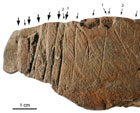 The engraving consisted of a more complex geometric pattern that looks like the letter “X” repeated in a connected series. Click to enlarge this image. Riaan Rifkin |
Stone Age Pebble Holds Mysterious Meaning (South Africa) 23 February 2012 The colorful pebble bearing a sequence of lines dates back 100,000 years and may be the first evidence of abstract art. The gist: The world's oldest known engraved object may be an ochre pebble from Klasies River Cave in South Africa. The 100,000-year-old ochre pebble features what researchers believe are at least 23 engraved lines. It's possible that the design was a symbol that communicated something meaningful to prehistoric humans. A colorful pebble bearing a sequence of linear incisions may be the world's oldest engraving. The object, which will be described in the April issue of the Journal of Archaeology, dates back approximately 100,000 years ago and could also be the world’s oldest known abstract art. It was recovered from Klasies River Cave in the Eastern Cape Province of South Africa. “Associated human remains indicate that the engraved piece was certainly made by Homo sapiens,” co-author Riaan Rifkin of the University of Witwatersrand’s Institute for Human Evolution told Discovery News. Rifkin and colleagues Francesco d’Errico and Renata Garcia Moreno performed extensive non-invasive analyses of the object. Methods like X-ray fluorescence and microscopic analysis enabled the researchers to examine every minute detail of the ochre pebble, which appears to have split off from a once larger piece. The scientists conclude that humans intentionally made the sub-parallel linear incisions on the Middle Stone Age pebble. “Upon engraving the piece with a sharp lithic implement, it is likely to have produced a markedly bright and dark red-maroon powder,” Rifkin said. “The design may therefore have been strikingly visible shortly after it was produced.” Ochre is a mineral-rich, naturally tinted clay that primarily consists of hydrated iron oxide. Ochre was among the earliest pigments used by humans and possibly other hominids for artistic purposes. Some even refer to it as the caveman's "crayon." The Klasies River object measures close to 3 inches in length and contains a series of seven “deep broad engraved lines and several, about 16 or so, narrower and somewhat shallower linear features,” Rifkin said. “The fragment is a remnant of a formerly semi-circular ochre pebble that likely contained a much more extensive engraved design on its surface.” Of particular interest now is whether or not the engraver made the design with symbolic intent. Use of symbols and meaningful images is thought to have been a significant breakthrough in human development. Language, math and countless other studies are tied to this basic skill, in addition to improved communication. To this day, art permits communication of identity and other things among diverse cultures. Both linear and crosshatch engraved patterns may have been common thousands of years ago. Similar designs appear on engraved ochres from Blombos Cave, also in South Africa, and on ostrich eggshell fragments found in the Diepkloof Rock Shelter in the Western Cape Province. Some of these, and other, similar objects may even predate the Klasies River pebble, but studies on them are ongoing. “The employment of red ochre for symbolic purposes likely played an important role in mediating increasingly complex social relations that emerged during the Middle Stone Age,” Rifkin explained. Christopher Henshilwood, a researcher at the University of Witwatersrand, did not work on this study, but he has examined other very early probable engravings. For example, he studied abstract markings of another piece of ochre dating to around 70,000 years ago. In that case, the engraving consisted of a more complex geometric pattern that looks like the letter “X” repeated in a connected series. The possible meaning of these lines remains a mystery, “but they are symbols that I think could have been interpreted by those people as having meaning that would have been understood by others,” Henshilwood said. At present, Rifkin and his team are studying 30,000-year old cave art from Africa. So far, they have determined that the abstract images depict a zebra, a rhino, and a half human, half cat therianthorpe. Source : By Jennifer Viegas on http://news.discovery.com/history/engraving-oldest-122302.html
|
 Students analyze a Nubian skeleton from the Middle Ages. More than 400 ancient skeletons from Africa are on loan to MSU from the British Museum. Credit: G.L. Kohuth  MSU students, from left, Lindsey Jenny, Tracey Tichnell and Cate Bird excavate graves in Sudan in 2007 to save the remains from a large dam that now covers the area. Credit: Richard Watts |
Making the bones speak (Sudan, East Africa) 22 February 2012 In a narrow, modest laboratory in Michigan State University’s Giltner Hall, students pore over African skeletons from the Middle Ages in an effort to make the bones speak. Little is known about these Nubians, meaning the information collected by graduate and undergraduate students in MSU’s Forensic Anthropology and Bioarchaeology Program will help shed light on this unexplored culture. “This is generally an unknown group of people, so what we get to do with the skeletal collection is really make the bones speak,” said Carolyn Hurst, a doctoral student in physical anthropology who is leading the lab this academic year. The 409 skeletons – dating from the sixth to 15th centuries – were rescued several years ago from gravesites on Mis Island, located along the Nile River in present day Sudan, before the region became a dam. The collection is on loan to MSU from the prestigious British Museum. Four MSU graduate students helped in the excavation. Now, another group of students – both graduate-level and undergraduates – are analyzing the bones for clues into the ancient Nubians’ diets, health histories and lifestyles. (To read more about their ongoing discoveries, click here.) Having direct access to a large, well-preserved set of ancient remains is rare for college students. The research experience provides a major advantage for MSU students looking to become professional anthropologists or forensic scientists. “There aren’t a lot of programs from across the world that have a collection like this,” said Todd Fenton, associate professor in the MSU Department of Anthropology and director of the Nubian bones project. “It gives our graduate students an amazing research platform and also provides exciting opportunities for our undergraduate students.” For years, Fenton and his students have worked with personnel from the British Museum on excavations in Albania. In the mid-2000s, when the massive Merowe Dam was being built in an area known as the Fourth Cataract of the Nile River, Derek Welsby from the museum turned to Fenton for help in excavating the medieval Nubian remains. Four MSU graduate students – Cate Bird, Lindsey Jenny, Tracey Tichnell and Andrea Clowes – traveled to Sudan to assist with the three-month excavation in early 2007. The work was undertaken by the Sudan Archaeological Research Society in collaboration with the British Museum. Under the brutal African sun, the MSU students, with help from museum fieldworkers and Sudanese citizens, carefully removed the skeletons from their burial sites, conducted a preliminary analysis of the bones, then boxed them up and shipped them to the British Museum in London. “I jumped at the opportunity to go to Sudan and see a region of the world that’s not very accessible,” said Bird, a doctoral student in anthropology. “We usually just see bones in the laboratory. To be able to have such a hand in excavating them and making sure they were handled properly and cared for was important to me.” The skeletons remained at the museum until May 2010, when they came to MSU through a five-year loan, which can be renewed. After cleaning and cataloguing the skeletons, a group of students spent the first academic year studying the adult skeletons. That project – led by Angela Soler, who recently earned her doctorate in anthropology – included analyzing the bones and teeth to determine dietary habits, sex, approximate age and evidence of illness or trauma. The information collected is entered into a database run by the British Museum, which is analyzing another set of remains from Mis Island. “We were extremely pleased to team up with MSU because of the unbridled enthusiasm of both Dr. Fenton and his students,” said Welsby, assistant keeper in the British Museum’s Department of Ancient Egypt and Sudan. “This is an ideal scenario in that we get the basic skeletal report to integrate into our final report on all aspects of the work at the Fourth Cataract while the students get the raw material to study.” Margaret Zywicki, a senior anthropology major from metro Detroit, worked in the Giltner Hall lab from the beginning – “when the bones were in boxes covered with dirt” – and is now applying to graduate schools. “I had no experience with bones before, so by working here I’ve gotten extensive experience that most undergraduates don’t get,” Zywicki said. “And now that I’m applying to graduate schools I have that experience on my resume and that’s something that should really catch their attention.” This year, the students, led by Hurst, are studying the child and adolescent skeletons. Kailey Shelton, a junior from Maryland, is enjoying the project so much she decided to pursue a bachelor’s degree in anthropology to go along with her history major. “It’s so neat to see the physical remains of something that’s a thousand years old,” Shelton said. “It’s the idea that something from so long ago is right here in front of me, and I’m able to tell something about that person from it. “As clichéd as it is, it’s where history comes alive, and that’s always been the thing that excites me the most.” Source : http://phys.org/news/2012-02-bones.html
|
|
Out of Africa? Data fail to support language origin in Africa (Africa) 15 February 2012 Last year, a report claiming to support the idea that the origin of language can be traced to West Africa appeared in Science. The article caused quite a stir. Now linguist Michael Cysouw from Ludwig-Maximilians-Universitaet in Munich has challenged its conclusions, in a commentary just published in Science. In the beginning was the word – yes, but where exactly? Last year, Quentin Atkinson, a cultural anthropologist at Auckland University in New Zealand, proposed that the cradle of language could be localized in the southwest of Africa. The report, which appeared in Science, one of the world's leading scholarly journals, was seized upon by the media and caused something of a sensation. Now however, linguist Michael Cysouw from Ludwig-Maximilians-Universitaet (LMU) in Munich has published a commentary in Science which argues that this neat "Out-of-Africa" hypothesis for the origin of language is not adequately supported by the data presented. The search for the site of origin of language remains very much alive. Atkinson based his claim on a comparative analysis of the numbers of phonemes found in about 500 present-day languages. Phonemes are the most basic sound units – consonants, vowels and tones – that form the basis of semantic differentiation in all languages. The number of phonemes used in natural languages varies widely. Atkinson, who is a biologist and psychologist by training, found that the highest levels of phoneme diversity occurred in languages spoken in southwestern Africa. Furthermore, according to his statistical analysis, the size of the phoneme inventory in a language tends to decrease with distance from this hotspot. To interpret this finding Atkinson invoked a parallel from population genetics. Biologists have observed an analogous effect, insofar as human genetic diversity is found to decrease with distance from Africa, where our species originated. This is attributed to the so-called founder effect. As people migrated from the continent and small groups continued to disperse, each inevitably came to represent an ever-shrinking fraction of the total genetic diversity present in the African population as a whole. So does such a founder effect play a similarly significant effect in the dispersal and differentiation of languages? Michael Cysouw regards Atkinson's finding as "artefactual". Cysouw, whose work is funded by one of the prestigious Starting Grants awarded by the European Research Council (ERC), heads a research group that studies quantitative comparative linguistics in LMU's Faculty of Languages and Literatures. He says he has no objection in principle to the use of methods borrowed from other disciplines to tackle questions in linguistics, but that problems arise from their inappropriate application. For example, he finds that if Atkinson's method is employed to examine other aspects of language, such as the construction of subordinate clauses or the use of the passive mood, the results "do not point in the same direction". Indeed, in their article in Science, Cysouw and his coauthors Steven Moran (LMU) and Dan Dediu of the Max Planck Institute for Psycholinguistics in Nijmegen show that, depending on the features considered, Atkinson's method places the site of origin of language in eastern Africa or the Caucasus or somewhere else entirely. As Cysouw points out, linguists have long sought to throw light on the origin of language by analyzing patterns of language distribution. The problem is that such relationships can be reliably traced only as far back as about 10,000 years before the present. (math/PH) More information: Science, 02/10/2012. Journal reference: Science search and more info website Provided by Ludwig-Maximilians-Universitat Munchen Source : http://phys.org/news/2012-02-africa-language.html
| |
 Archaeologist Chris Henshilwood explores a cave on South Africa's Southern Cape. At nearby Blombos cave, Henshilwood has found some of the oldest evidence of symbolic thought by humans.  Stone tools from Blombos Cave. 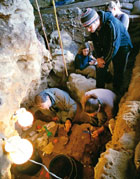 Archaeological excavations at Blombos Cave have yielded early evidence of abstract thought. |
Human evolution: Cultural roots (South Africa) 15 February 2012 A South African archaeologist digs into his own past to seek connections between climate change and human development Metal scrapes on hard sand as archaeologist Chris Henshilwood shaves away the top layer of sediment in Blombos Cave. After just a few moments, the tip of his trowel unearths the humerus of a pint-sized tortoise that walked the Southern Cape of South Africa many millennia ago. Next come shells from local mussels and snails amid blackened soil and bits of charred wood, all remnants of an ancient feast. It was one of many enjoyed by a distinct group of early humans who visited Blombos Cave over the course of thousands of years. The Still Bay culture was one of the most advanced Middle Stone Age groups in Africa when it emerged some 78,000 years ago in a startlingly early flourishing of the human mind. Henshilwood's excavations at Blombos Cave have revealed distinctive tools, including carefully worked stone points that probably served as knives and spear tips, and bits of rock inscribed with apparently symbolic designs. But evidence of the technology disappears abruptly in sediment about 71,000 years old, along with all proof of human habitation in southern Africa. It would be 7,000 years before a new culture appeared, with a markedly different toolkit, including crescent-shaped blades probably used as arrowheads. What drove the coming and going of these early cultures? At about the time the Still Bay culture disappeared, the globe — already in the middle of a glacial period — began to cool even further, causing sea levels to fall (see 'Crucible of culture'). “Humans are very adaptable,” says Henshilwood, “but I think climate must have played some role in the demise of the Still Bay.” If there is a link, it may hold broader implications. Genetic data suggest that the entire population of modern humans contracted at around the same time, then rebounded and expanded in Africa and onto other continents. Multiple teams are now racing to determine the part climate might have played in driving human evolution during this period. Blombos Cave, with its detailed archaeological record of the Middle Stone Age, could become a key testing ground. With Francesco d'Errico, an anthropologist at the French National Centre for Scientific Research (CNRS) in Bordeaux, Henshilwood has assembled a team of archaeologists, climate modellers and palaeoclimatologists for a five-year, €2.5-million (US$3.3-million) project to look at correlations between climate and culture during the eventful span of prehistory that includes Still Bay, and the beginnings of modern human behaviour. “These are very daunting questions indeed, but I think they are answerable,” says Henshilwood, a native of Cape Town who now works at the University of Bergen in Norway. “If we can get some good climatic data, we can at least hazard some guesses.” Personal history Outside the cave, a cool November breeze scours the steep slope to the shore, which Henshilwood has known since he was a child. His grandfather bought this land on the Southern Cape as a fishing retreat in 1961 and Henshilwood spent his holidays searching the hills and caves for ancient artefacts. Those experiences served him well in 1985, when, out of sheer boredom in his mid-thirties, he decided to leave the family department-store business and enrol in an archaeology course at the University of Cape Town. In 1991, as a PhD student on a scholarship at the University of Cambridge, UK, he returned to Blombos in search of the same kind of artefacts that he had found as a child. What he discovered was much more significant and far older: a series of bone tools and double-sided stone points that were clearly tied to the enigmatic Still Bay period. “It was right over there,” he says, motioning to the back of the cave. “Nobody believed us, because nobody had found a Still Bay site for 40 years.” The Middle Stone Age was not part of his thesis, so Henshilwood covered the site up and moved on. Only in 1997 did he secure funding for a full excavation from the US National Science Foundation. In 2002, Henshilwood published a study1 in Science documenting pieces of red, iron-rich rock called ochre, which were engraved with cross-hatched patterns. He argued that the 77,000-year-old etchings were examples of symbolic behaviour and represented the earliest known evidence of abstract thought. These and other findings have challenged the once-dominant idea that human culture — as exemplified by art such as carvings and jewellery — appeared in an explosive transformation during the Late Stone Age, some 40,000–50,000 years ago, in north Africa and Europe. Blombos and other sites suggest a more gradual cultural and technological development, beginning far earlier, during the Middle Stone Age throughout Africa. On a visit to Blombos in November, the cave looks like a war bunker, complete with a generator, lights and sandbags. The team has excavated just enough earth to create a workspace for a crew of five. Hundreds of steel tabs mark strata on vertical walls of sediment. While Henshilwood works on the cave's top layer, from 72,000 years ago, his partner and co-excavator, Karen van Niekerk, sifts through the bottom strata of sediments, which are roughly 100,000 years old. Centimetres away, the same layer yielded Henshilwood's most recent blockbuster find2: a toolkit of shells, grindstones and crushing stones used to process and store ochre, possibly for use as pigment or for utilitarian purposes such as tanning hides or cleaning wounds. It was further evidence that Homo sapiens had developed planning skills and sophistication far earlier than was once believed. Now a postdoctoral researcher at the University of Bergen, van Niekerk has been working with Henshilwood since the early days at Blombos. It's a good life, she says, “and a lot of work”. On this day she finishes early and heads to Henshilwood's beach house and scientific base to help a master's student, Cornelia Albrektsen, to conduct an experiment using home-made stone and bone tools. They struggle for the better part of an hour trying to replicate the way ancient people might have opened shellfish. Then Henshilwood shows up. “Give me one,” he says, grabbing a shell. Within minutes, Henshilwood pops open several snails and determines which tools work best. He then departs to clean up for dinner, leaving the stunned crew to finish the experiment. “It was really impressive,” Albrektsen says later. “He was getting all caveman-like.” During a break in the excavations, Henshilwood stares out to sea and wonders aloud whether the Indian Ocean holds answers. Palaeoclimate records from marine sediment and ice cores suggest3 that around the time the Still Bay culture disappeared, global temperatures dropped and the polar ice sheets grew. Ocean levels fell, and the Still Bay people may have followed the sea onto the continental shelf, which would have become a productive plain. If this idea is accurate, most of the evidence would have been submerged as the ocean returned over the past 15,000 years. Henshilwood has hiked along more than 240 kilometres of coastline in search of caves that might hold clues to the fate of the Still Bay. He hasn't found any yet, but he is beginning excavations on a site called Klipdrift Shelter, west of Blombos, that could allow him to look at the rise of Still Bay's successor: the Howiesons Poort culture, which appeared 65,000 years ago and persisted for about 5,000 years. Time and tide Taking a break from Blombos, Henshilwood visits the new site with Simon Armitage, a mineral-dating specialist at Royal Holloway University of London. Armitage uses a technique called optically stimulated luminescence to determine the last time a sample of dirt saw sunlight before being buried. The method requires Henshilwood and others to cover Armitage with a thick black tarpaulin and sit on its edge to prevent any light from fouling the measurements. While waiting, Henshilwood talks about the significance of the site, which has already yielded a human tooth and some artefacts with markings that could be engravings. He says the findings may turn out to be more fascinating than the decorated ochre pieces that made Blombos famous. Once the site has been dated, the researchers will add it to environmental and cultural records from southern Africa and Europe. To construct a climate record, Henshilwood's team is sampling cave deposits, in search of clues to ancient rainfall and temperatures. They are also testing ocean sediment cores for pollen and traces of charcoal that hint at vegetation, rainfall and the frequency of fires. The palaeoclimate data will allow a team at the CNRS to build a high-resolution model of climate in Europe and southern Africa, beginning with the time spanning the Still Bay and Howiesons Poort cultures. The last step is to overlay the climate and cultural data onto an ecological model to analyse the environmental space occupied by specific cultures throughout time. The team can then look for links. Was one industry, for example, always associated with a particular environment? Do similar cultures occupy similar landscapes or respond to climatic shifts in similar ways? “We can start to test our hypotheses about the role of ecology and the environment,” says William Banks, who runs the modelling at the CNRS in Bordeaux. Henshilwood and his colleagues have some friendly competition. Curtis Marean, an archaeologist at Arizona State University in Tempe, came to the cape shortly after Henshilwood, inspired by the genetic evidence of a population crash in the Middle Stone Age and thinking that the cape would have been a good place for humans to ride out hard times. He partnered with Henshilwood on a paper4 examining bone tools from Blombos in 2001 and went on to document the use of pigments5 and heat-treatment of stone tools6 164,000 years ago at Pinnacle Point, less than 100 kilometres east of Blombos. He is also looking to the sea for answers. Marean and a team of researchers have already produced an assessment3 of historical sea levels around Pinnacle Point, and now they have received money from the National Geographic Society in Washington DC and the US National Science Foundation to build a detailed geophysical map of the continental shelf. Marean thinks that the exposed shelf would have been a diverse shrubland ecosystem with edible roots, big game for hunting and marine resources. His goal is to reconstruct the vegetation, and then use models to analyse how people might have exploited those resources. “We need to develop a thick empirical record and put that into a really tight timescale,” says Marean. “Once we have that, we can start debating the whys.” Alison Brooks, director of the Center for the Advanced Study of Hominid Paleobiology at the George Washington University in Washington DC, says that Henshilwood and others are producing much-needed data and hypotheses, but she warns against the dangers of oversimplification. Brooks is co-authoring a forthcoming publication that aligns palaeoclimate data with archaeological data throughout Africa, and she says that each region of the continent seems to have has its own story. “There's a lot of complexity here,” she says. Henshilwood acknowledges that comparing environmental and cultural data may not yield concrete answers. The disappearance of the Still Bay, he says, could have resulted from climatic change, migration, the arrival of new people or simply cultural evolution over the course of thousands of years. Back in the cave, Henshilwood settles down into a familiar routine: digging carefully through the sediments and thinking about the past. He uncovers the remains of a clam that lives along sandy beaches and a mussel that prefers rocky shores, evidence that the Still Bay people had access to a varied coastline much like the one he has been exploring all his life. Just behind Henshilwood is another hole, carefully filled with sandbags. He dug that in 2007 as a test plot and found that the sediments inside Blombos date back at least 130,000 years, with artefacts dispersed throughout. “But that's for another day,” he says, glancing at the wall of dirt in front of him. “Or another year, another decade.” Source : http://www.nature.com http://www.nature.com/news/human-evolution-cultural-roots-1.10025
|
|
Tunisia: Discovery of a Roman Cemetery in Djerba (North Africa, Tunisia) 14 February 2012 A chance discovery of around 100 Roman graves was made recently near el Kantra - located in the island of Djerba's southern region. Employees working for the STEG (the Tunisian Society of Electricity and Gas) as well as employees from the Ministry of Equipment and Housing uncovered the graves while they were carrying out work in the region. An employee from the STEG, who was present when the discovery was made, confirmed that while the staff was digging to repair a gas pipeline they discovered fragments of marble, pottery, clothes, coins, and human bones. The employees did not recognize that the area was a cemetery until they invited archaeologists to investigate the site. Youssef el Cherif, a Tunisian archaeologist, confirmed that the graves discovered in "el Kantra" appeared to be connected to the archaeological site of Meninx. Originally a manufacturing center established by Phoenicians as early as the 10th Century BC, Meninx developed into an important and prosperous economic city under the Romans thanks to its strategic position at the geographical crossroads of ancient trade routes. At its peak Meninx was the capital of the island and boasted thermal baths, an amphitheater, a theater, a basilica and possibly a forum. A team of archaeologists will begin a more detailed investigation of the new discovery in the coming days. Source : http://popular-archaeology.com http://popular-archaeology.com/issue/december-2011/article/arabia-the-first-stop-for-modern-humans-out-of-africa-suggests-new-study
| |
 |
Ancient Farmers had Impact on Disappearance of African Rainforests (Central Africa) 9 February 2012 Scientists have long held that some of the rainforests of Central Africa disappeared about 3,000 years ago, abruptly replaced by savannas due to a dramatic shift in the regional climate. However, the conclusions of a recent study now suggest that it was not climate change alone that may have been responsible for the shift -- that humans may have had a big hand, as well. Germain Bayon and a research team of colleagues conducted a geochemical analysis of a marine sediment core taken at the mouth of the Congo River and determined that the sediment had undergone very significant chemical weathering around 3,000 years ago. While climate change at the time was a factor, the weathering also coincided with the arrival of Bantu-speaking farmers from the region that now encompasses modern-day Cameroon and Nigeria. These Bantu peoples, according to the researchers, brought their agriculture and iron smelting technologies with them, possibly contributing to and enhancing the changes that impacted the Central African rainforests. As they intensified their land use by cutting down trees to create arable land for agriculture and iron smelters, the ensuing erosion and effects on the climate helped to create a drier, more savannah-like landscape around 3,000 years ago, resulting in the conditions we see today. Reports Bayon, et. al., "evidence from our proxy record that chemical weathering rates at that time were unprecedented during the last 40 thousand years clearly suggest that the environmental impact of human population in the central African rainforest was already significant about 2500 years ago, at least greater than that induced by the Late Quaternary (the past 0.5-1.0 million years) climatic oscillations"[1]. This paper is published online by the journal Science, at the Science Express website, on Thursday, 09 February. Seehttp://www.sciencexpress.org. [1] "Intensifying Weathering and Land-Use in Iron Age Central Africa," by G. Bayon; B. Dennielou; J. Etoubleau; E. Ponzevera; S. Toucanne; S. Bermell at IFREMER in Plouzané, France. This work was sponsored by the French National Research Agency (ANR), via the ECO-MIST project. Source : http://popular-archaeology.com http://popular-archaeology.com/issue/december-2011/article/ancient-farmers-had-impact-on-disappearance-of-african-rainforests
|
|
Czech archaeologists discover long-lost temple in Sudan (Sudan, East Africa) 27 January 2012 Prague, Jan 26 (CTK) - Czech archaeologists have found a long lost temple from the Meroe period near the town of Vad Bon Naga in Sudan, Pavel Onderka, from Prague's Naprstek Museum of Asian, African and American Cultures, told journalists yesterday. The large temple compound is situated 130 km northwards of Khartoum. European travellers saw the remains of the temple in the early 19th century but then the temple disappeared in the desert, said Onderka who leads the Czech archaeology expedition. He said the Czech expedition revealed a signet ring with a picture of Nubian Lion god Apede-mak, a statuette of the originally Egyptian god Osiris, a stone with a Meroe hieroglyphs and parts of sandstone blocks. Czech archaeologists have been working in the Vad Bon Naga locality for three seasons. In the Meroe Kingdom period, from the 4th century B.C. to the 4th century A.D., the site hosted one of the ancient Nubia's biggest towns, Arabikeleb. Around the turn of the millennium, a big palace and at least five temples were built in the town with 25,000 inhabitants. Czech archaeologists previously uncovered a palace belonging to Queen Amanishakheto, who ruled in the 1st century B.C. In the past season they continued the conservation and restoration works in the palace, which is the best preserved of all Meroe-era palaces. The Sudanese expedition is a continuation of the long tradition of Czech archaeological and etnographic research in the Nile Valley. Apart from conducting research, Czech archaeologists in Sudan have established contacts with local inhabitants. They mediated a partnership between Van Bon Naga and the Czech town of Otrokovice. They also help support local schools. They originally wanted to build a well in Vad Bon Naga but concluded that the plan was unfeasible due to the local geological conditions. As a result, they decided to build waterworks to provide drinking water. The locality lacks drinking water and people use water from the Nile. Source : http://praguemonitor.com http://praguemonitor.com/2012/01/27/czech-archaeologists-discover-long-lost-temple-sudan
| |
 |
Arabia the First Stop for Modern Humans Out of Africa, Suggests New Study (Africa) 26 January 2012 Questions surrounding when and where early modern humans first migrated from Africa to populate the rest of the world have long been a focus of debate and study among scientists, where genetic research has played a key role. Now, recent genetic research study results have been released by an international team of scientists. The research, published January 26 by Cell Press in the American Journal of Human Genetics, suggests that modern humans settled first in Arabia more than 60,000 years ago on their way out through the Horn of Africa. Says senior study author Dr. Luisa Pereira of the University of Porto in Portugal (IPATIMUP): "A major unanswered question regarding the dispersal of modern humans around the world concerns the geographical site of the first steps out of Africa. One popular model predicts that the early stages of the dispersal took place across the Red Sea to southern Arabia, but direct genetic evidence has been thin on the ground." Led by Pereira and Professor Martin Richards at the University of Leeds in the UK, in collaboration with colleagues from across Europe, Arabia, and North Africa, the researchers investigated this question by conducting a study of three of the earliest non-African maternal lineages associated with the time period when modern humans first migrated out of Africa. They compared data taken from mitochondrial DNA genomes from Arabia and the Near East with that of hundreds of other samples from Europe. Mitochondrial DNA, which traces the line of female descent in populations, has been extensively used by scientists to determine how different populations are related, thus revealing clues about human migratory patterns. "Taken together, our results suggests that Arabia was indeed the first staging-post in the spread of modern humans around the world," concludes Richards, study co-author and currently Professor of Archaeogenetics at the University of Huddersfield. Details of the study are published in Fernandes et al., The Arabian Cradle: Mitochondrial Relicts of the First Steps along the Southern Route out of Africa, The American Journal of Human Genetics (2012), doi:10.1016/j.ajhg.2011.12.010. The research was funded by the Portuguese Foundation for Science and Technology, the Leverhulme Trust, and the DeLaszlo Foundation. Source : http://popular-archaeology.com http://popular-archaeology.com/issue/december-2011/article/arabia-the-first-stop-for-modern-humans-out-of-africa-suggests-new-study
|
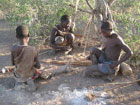 |
Facebook in our Genes? (Southern Africa) 25 January 2012 This was Hadza land, a type of rugged African landscape that we have all seen in pictures and movies about the African Serengeti. Coren Apicella and her research assistants were frequently on the move, traveling the region by Land Cruiser, struggling to cross mud-drenched trails. At one location, they had to lay felled trees on the ground in order to advance, and at another point, they had to flee a horde of elephants. But it all came with the territory. They were studying a nomadic people called the Hadza, or Hadzabe, an ethnic group of people in north-central Tanzania, living around Lake Eyasi in the central Rift Valley and in the neighboring Serengeti Plateau. The Hadza people number less than 1,000 in total population. Roaming over 4,000 square kilometers of the African landscape, several hundred of them still live as hunter-gatherers, much as their ancestors lived tens of thousands of years ago before the invention of agriculture. Some consider them to be the last full-time hunter-gatherers in Africa. To Coren and other researchers, they offer an interesting case for ground-breaking research and discovery about the dynamics and evolution of social networking in the human family, one element that made modern humans what they are today. Their study produced some illuminating results. The findings brought to light some key elements of social network structures that may have existed tens of thousands of years ago, or perhaps even hundreds of thousands of years ago, in the formative years of human history. They suggest how our ancestors formed social networks, contributing to the evolution of cooperation. "We found that what modern people are doing with online social networks is what we've always done—not just before Facebook, but before agriculture," said James Fowler, professor of medical genetics and political science at the University of California, San Diego, and study co-author. Nicholas Christakis, a senior author of the study and professor of medical sociology and medicine at Harvard Medical School and professor of sociology in the Harvard Faculty of Arts and Sciences, agrees: "From the time we were around campfires and had words floating through the air, to today when we have digital packets floating through the ether, we've made networks of basically the same kind." Apicella and her assistants interviewed 205 adult Hadza over a two-month period to measure their tendency to cooperate and to map their friendships. As part of the study, they asked adult individuals who they would prefer to live with at their next encampment. Then, they gave each adult three straws of honey and were told they could give them to anyone in their camp. Both activities created 1,263 campmate ties and 426 "gift" ties. As a separate experiment, the researchers measured cooperation by giving them additional honey straws that they could optionally keep or donate to the group as a whole. They also measured connectedness of the people by height, age, food preference, and other characteristics, and the likelihood that a person's friends are also friends with one another. When the networks were analyzed, they found that cooperators and non-cooperators developed distinctly different clusters. Said Apicella, "If you can get cooperators to cluster together in social space, cooperation can evolve. Social networks allow this to happen." The premise is that for cooperation to evolve, altruistic acts, such as sharing food with a non-relative, must benefit both receiver and giver in some way. If not for this, as the principle goes, self-serving persons would essentially overcome and replace those that are selfless, leading to societal collapse. At least theoretically, the evolution of cooperation depends on the existence of a system that makes it possible for the cooperators to group together with others who also tend to share. Equally as significant, the study found that the data that described the structure and dynamics of the Hadza hunter-gatherer social networks were basically the same as the data drawn from modern communities. "We turned the data over lots of different ways," said Fowler. "We looked at over a dozen measures that social network analysts use to compare networks and pretty much, the Hadza are just like us." Apicella, Fowler and Christakis designed the study, working with Hadza expert Frank Marlowe, a lecturer in the Department of Archaeology and Anthropology of the University of Cambridge. The research was funded by the National Institute on Aging and by the Science of Generosity Initiative of the University of Notre Dame. The findings, detailed in the article, "Social Networks and Cooperation in Hunter-Gatherers" by Coren L. Apicella, et al., are published in the January 26, 2012 issue of Nature. See video below for additional information about these findings. Source : http://popular-archaeology.com http://popular-archaeology.com/issue/december-2011/article/facebook-in-our-genes1
|
|
Anthropology researcher searches for slave-era shipwreck (South Africa) 19 January 2012 Anthropology professor Stephen Lubkemann thinks his planned trek into the sea will soon help shape the understanding of one of the ugliest aspects of human history: the trans-Atlantic slave trade. Lubkemann has spent two years pinpointing the site of a shipwreck near Cape Town, South Africa that killed more than 200 slaves being transported between East Africa and the Americas during the 1790s. If he reaches the sunken ship, he says the findings will add the first archaeological evidence to the 18th-Century slave trade. The search of the South Atlantic Ocean is one of five research initiatives piloted by GW professors that now have the support of an 18-month-old joint fund between the University and the Smithsonian Institution. The time since the partnership’s establishment was spent vetting project ideas and selections were announced Jan. 12. Alongside Smithsonian curator Paul Gardullo, Lubkemann will lead a team of nine researchers from the U.S. and South Africa to the ocean floor in hopes that getting an up-close view of the shipwreck will reveal historical details. “This is an area where archaeology could possibly make some contributions that would be unique,” Lubkemann said. He added that although other teams of archaeologists have already studied shipwrecks from the trans-Atlantic slave trade, this effort would be the first to analyze a ship that was carrying slaves when it sunk. Examining the ship’s size and technology will reveal goals and priorities for the slave traders – like concern about a British blockade or the importance of speedy transport, Lubkemann said. A panel of four researchers from GW and four from the Smithsonian chose the five research projects over the last several months. The judges whittled 13 proposed projects down to five, each of which includes researchers from both organizations, University spokeswoman Angela Olson said. Each project received $40,000 – an even split of the $200,000 contributed jointly by the University and the Smithsonian Institution. The other four projects will tackle subjects spanning from the effects of primate breast milk on infant growth to the political and cultural ecologies of cell phones. The Smithsonian Institution hopes the findings of the shipwreck study will contribute to its National Museum of African American History and Culture. The other projects will also work with Smithsonian museums and research centers. “In the long term, some of our partners, such as the Smithsonian, are very interested in how the material we might locate can be used in their education programs to bring this kind of history to life for people who are not going to be diving at these sites like we are.” Lubkemann said. Source : http://www.gwhatchet.com & Liza Dee http://www.gwhatchet.com/2012/01/19/anthropology-researcher-searches-for-slave-era-shipwreck/
| |
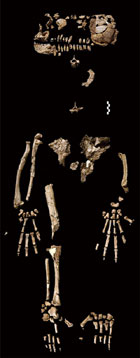 Ardipithecus ramidus |
River bank life of Early Humans (Ethiopia, East Africa) 15 January 2012 Many people conjure up images of our earliest human ancestors living in the hot dried out dusty environments where many of their remains have been found. Unfortunately, such images don’t take into account the changes in environment that have occurred since those times when early peoples walked the Earth. Archaeologists of course have thought of such things and for many years have thrown ideas back and forth debating whether these people may actually have lived by rivers and streams – as those that came later built civilizations along rivers such as the Nile – or whether they lived in woodlands. Now new evidence has come to light that suggests the former might be more likely. Husband and wife team Royhan and Nahid Gani have been studying the sediments surrounding the place where Ardipithecus ramidus, aka, “Ardi,” was found in Ethiopia and have discovered that most of the evidence in the area points to a group of people that lived near a very large river. Their paper on the subject will be published in Nature Communications. Ardi is believed to have lived some four and half million years ago in what is now Aramis, a hot and dry part of Ethiopia, but until now no serious study had been done on the earth in which the skeletal remains were found. After doing so, the Gani’s discovered that the earth was actually layers of sandstone most likely the result of an ancient stream overflowing it’s banks periodically. Branching out, the team discovered that the sediments indicated that this stream was actually a river, measuring twenty six feet deep and over twelve hundred feet wide. Next they turned their attention to plant material that had been preserved in the sandstone, measuring their isotopes, and found that the material had come from grassy plants, suggesting a savannah type environment. But once again, widening their area of study, they also found that there were large changes in the types of plant material in the area. This caused them to surmise that there were patches of forests near the rivers and streams. Based on these two pieces of information, the team suggests that it appears Ardi, who many researchers believe is our oldest found ancestor, lived in a savannah, near fresh flowing water. Some suggest that such an environment would be consistent with learning to walk upright to see over the tall grasses. More information: River-margin habitat of Ardipithecus ramidus at Aramis, Ethiopia 4.4 million years ago, Nature Communications 2, Article number: 602 doi:10.1038/ncomms1610 Source : http://www.pasthorizonspr.com http://www.pasthorizonspr.com/index.php/archives/01/2012/river-bank-life-of-early-humans
|
 |
New Early Warning System Spotlights Endangered Archaeological and Cultural Heritage Sites (Africa) 8 January 2012 The Global Heritage Network (GHN), the world's first early warning and site monitoring system dedicated exclusively to endangered cultural heritage sites in developing countries, became operational in March of 2011. Since then, GHN efforts have been joined by hundreds of conservation experts around the world. The Network features updated satellite imagery for 175 of the developing world’s most significant archaeological and cultural heritage sites, including profile information on at least 80 of those sites. The Network has been spotlighted by major media organizations such as National Geographic and USA Today. What may come as a surprise to many, however, are some of the world's long-held, well-known "celebrity" sites that the GHN has determined to be in need of urgent rescue: Egypt's Ancient Thebes with its necropolis, as well as Ancient Abydos; Leptis Magna, Libya; Great Zimbabwe National Monument in Zimbabwe; and Tiwanaku, Bolivia. These are sites that are defined as "in critical need of conservation intervention to ensure long term preservation". The less urgent but still critical "at risk" designation has been assigned to such other well-known sites as Petra, Jordan; Teotihuacan, Mexico; Egypt's Memphis and its necropolis and the pyramid fields from Giza to Dahshur; Ur, Iraq; and lesser-known Göbekli Tepe, Turkey, a site that is considered perhaps the oldest Neolithic monumental center in the world. And "destroyed" are the cultural landscape and archaeological remains of the Bamiyan Valley in Afghanistan (which made relatively recent news headlines) and the Allianol Roman Bath complex in Turkey. These are "sites that have been completely destroyed due to natural disasters, looting, war & conflict, development pressures, or other factors". Using Google Earth and social networking, combined with scientific mapping software from Esri, satellite imagery from DigitalGlobe, and imagery analysis software from Exelis Visual Information Solutions (formerly ITT Visual Information Solutions), GHN has now provided a real-time interactive database tool for international experts, local communities, fundraisers, volunteers and visitors/travelers. It is hoped that the database will help global efforts to protect, preserve and sustain critical archaeological and cultural heritage sites, sites that exhibit significant cultural value to the world -- and an untapped potential for facilitating much-needed economic growth in the developing country hosts. Initial efforts to realize the Network's vision do seem to be working. “The success and growth of GHN in its first year is an encouraging sign for the long-term protection of our global heritage,” said Jeff Morgan, Executive Director of GHF. "Already, thanks to GHN, we are seeing individuals come together in the hundreds to protect and preserve our cultural heritage for future generations.”[1] The GHN website features a GHN Community social network, already consisting of at least 71 groups and more than 870 members that include professionals, students and volunteer enthusiasts. Experts, funders and enthusiasts aside, simply raising awareness among the public about these sites is a prime goal of the GHN efforts. Any person can now visit the network's website and view updated satellite imagery and maps of the sites, read profile overviews that relate the history, significance and threats, review detailed site conservation assessment reports, and view photos and videos. Although much has been accomplished in a short time, GHN administrators know that there is a long way to go before the ultimate purpose of the network can be fulfilled. "Major archaeological and cultural heritage sites are being damaged and destroyed at an alarming rate around the globe", say planners....."perhaps nowhere as quickly as in developing countries and regions with limited financial resources or expertise available."[2] [1] http://globalheritagefund.org/onthewire/blog/global_heritage_network [2] http://globalheritagefund.org/gh_network/about Source : http://popular-archaeology.com/ http://popular-archaeology.com/issue/december-2011/article/new-early-warning-system-spotlights-endangered-archaeological-and-cultural-heritage-sites
|
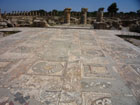 Cyrene was an ancient Greek colony and then a Roman city in present-day Shahhat, Libya, the oldest and most important of the five Greek cities in the region. Image: Travcoa Travel, Flickr |
Spreading a message of hope for Libyan archaeology (Lybia, North Africa) 7 January 2012 Libya boasts a rich cultural heritage; Palaeolithic rock paintings, Greek and Roman ruins and ancient desert oases. These historic treasures, including six UNESCO World Heritage sites, have suffered years of neglect and most recently the perils of conflict. During the conflict in Libya there were allegations that pro-Qadhafi troops and missiles were being hidden in the ancient city of Leptis Magna and that Qadhafi was using it as an archaeological shield. With such explosive storage, the risk of damage was great, but the sites of Leptis Magna and Sabratha have survived the conflict unscathed. That is excellent news for the cultural heritage of Libya and the tourism industry that the nation hopes to resurrect. Conflict is not the only threat to ancient artefacts. There is also the risk that a breakdown in law and order can give criminals the opportunity to steal items of great significance. In perhaps the worst case of looting during the conflict, nearly eight thousand ancient gold, silver and bronze coins, as well as a small number of artefacts, were stolen from a Benghazi bank vault. In some areas documentation, archiving and cataloguing was never carried out, making it difficult to estimate the loss to Libya’s cultural heritage. But, by and large, Libya seems to have avoided the kind of cultural looting and vandalism that occurred after the invasion of Iraq. ‘No strike’ list In a first of its kind initiative, two men were instrumental in setting up a ‘No Strike List’ of heritage and cultural sites that should be preserved in the conduct of air operations. They were Karl Von Habsburg, President of the ‘Blue Shield Committee’ in Austria and Dr Joris Kila, teacher at the University of Amsterdam and Chairman of ‘The International Military Cultural Resources Work Group’. They have now returned to make an assessment of the damage inflicted by the conflict on Libya’s heritage. “We both know the importance to be fast and in a place where there is a potential conflict or an actual conflict,” says Karl, “you have to be there really fast to make an assessment and to see what you can do to immediately help.” The two have been granted special access to sites that several months earlier had been welded shut for protection, a practice both experts agree is critical to protect heritage in times of unrest. While it works for museums, protecting sites like Leptis Magna and Cyrene in wide-open spaces is a lot more difficult. The work they are undertaking fills the gap in the protection of heritage sites until the Libyan Government is able to take over. “We hope that we will encourage them to take over part of our duties,” says Joris, “and do the work that has to be done.” Some of the sites they visited had been in close proximity to air strikes and escaped with only cosmetic damage. “It seem like our no strike list with cultural sites was very effective,” Joris notes, “because we didn’t find serious damage with bombardments by NATO on cultural sites.” Returning to help It is not only international archaeologists coming to the aid of Libya’s ancient sites. Hafed Walda is a Libyan archaeologist who lives in the UK. He has returned to his homeland to safeguard its cultural heritage. “My family came from a place in Misrata near to Leptis Magna,” says Hafed. “I was always fascinated about it, and once I had the opportunity to study the art and architecture I became interested in how to preserve this for the next generation.” Hafed believes that one of the biggest problems facing cultural sites in Libya is the lack of training and resources for those tasked with protecting them. “I see some of the heritage being neglected and marginalised to the degree where sometimes you feel despair. The people here don’t have the resources; sometimes they don’t have the know-how.” Hafed has been promoting his message through the media and reaching out to international organisations in the hope that they will be able to help. “It is important for everybody to make sure Libya really uses their heritage as their identity because really it’s the world’s heritage so Libya will be assimilated into the world. It’s a huge task, it is really a big task and Libya cannot do it on its own.” Source : http://www.pasthorizonspr.com & NATO http://www.pasthorizonspr.com/index.php/archives/01/2012/spreading-a-message-of-hope-for-libyan-archaeology
|
 |
Look into the eyes of a rare ancient African sculpture (Nigeria, West Africa) 6 January 2012 If they exist at all, most unglazed clay objects from ancient times are now rubble, mere fragments of their former glory. This terracotta head, at around 2000 years old, is a rare exception. Excavated from a village in Nigeria, this is one of the best-preserved examples of its kind ever discovered. It is a product of the Nok culture that flourished from about 1000 BC to AD 500, when it mysteriously died out, and provides examples of the earliest figurative art in sub-Saharan Africa. Archaeologists Peter Breunig and Nicole Rupp of the Goethe-University Frankfurt in Germany uncovered the head during the 2010 field season. It was found in Kushe, a small village about 150 kilometres north of the capital Abuja. Amazingly, this specimen was very close to the surface - only 60 centimetres down. The Nok terracottas are a mystery. No one knows for sure what they were used for. They may represent dead members of the Nok community and could have been a votive offering at a shrine. Alternatively, the figurines may have been grave goods. Africa has seen a resurgence of archaeological activity to investigate Nok culture. Part of this has to do with interest in Iron Age societies in Africa, which is surging as anthropologists consider how technologies - especially those based on iron - spread. The Nok are considered to be one of the earliest, if not the earliest, people to smelt iron on the African continent. However, the research is under threat. Over the past half-century countless Nok terracotta specimens have been looted from hundreds of sites in central Nigeria. The booty has found its way onto the international art and antiquities market, ending up in the hands of private art collectors. Source : http://www.newscientist.com & Curtis Abraham, contributor http://www.newscientist.com/blogs/shortsharpscience/2012/01/look-into-the-eyes-of-a-rare-a.html
|